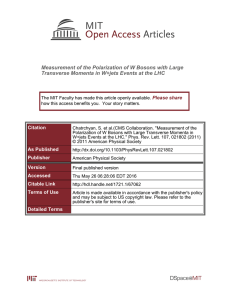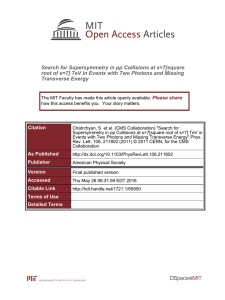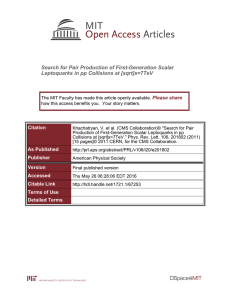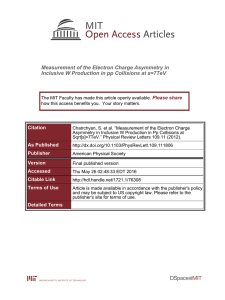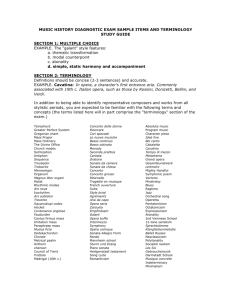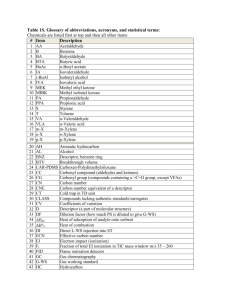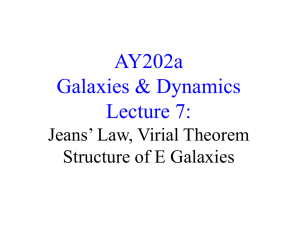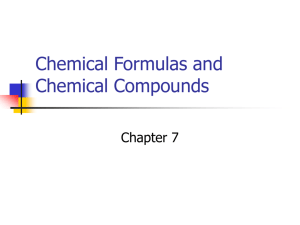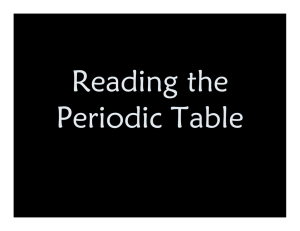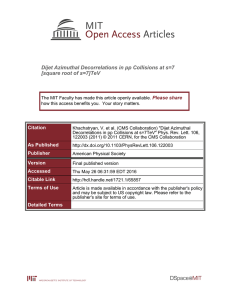Search for a Light Pseudoscalar Higgs Boson in the Please share
advertisement
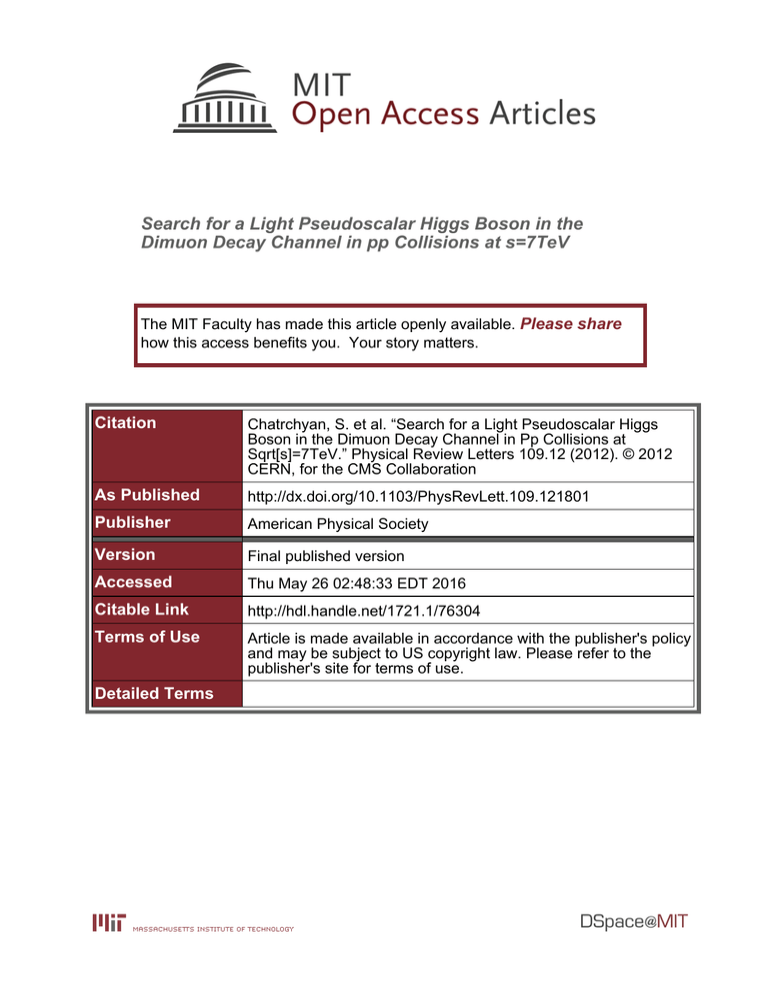
Search for a Light Pseudoscalar Higgs Boson in the Dimuon Decay Channel in pp Collisions at s=7TeV The MIT Faculty has made this article openly available. Please share how this access benefits you. Your story matters. Citation Chatrchyan, S. et al. “Search for a Light Pseudoscalar Higgs Boson in the Dimuon Decay Channel in Pp Collisions at Sqrt[s]=7TeV.” Physical Review Letters 109.12 (2012). © 2012 CERN, for the CMS Collaboration As Published http://dx.doi.org/10.1103/PhysRevLett.109.121801 Publisher American Physical Society Version Final published version Accessed Thu May 26 02:48:33 EDT 2016 Citable Link http://hdl.handle.net/1721.1/76304 Terms of Use Article is made available in accordance with the publisher's policy and may be subject to US copyright law. Please refer to the publisher's site for terms of use. Detailed Terms PHYSICAL REVIEW LETTERS PRL 109, 121801 (2012) week ending 21 SEPTEMBER 2012 Search for a Light Pseudoscalar Higgs Boson pffiffiffi in the Dimuon Decay Channel in pp Collisions at s ¼ 7 TeV S. Chatrchyan et al.* (CMS Collaboration) (Received 27 June 2012; published 20 September 2012) The dimuon invariant mass spectrum is searched in the range between 5.5 and 14 GeV for a light pseudoscalar Higgs boson a, predicted in a number of new physics models, including the next-to-minimal supersymmetric standard model. The data sample used in the search corresponds to an integrated pffiffiffi luminosity of 1:3 fb1 collected in pp collisions at s ¼ 7 TeV with the CMS detector at the LHC. No excess is observed above the background predictions and upper limits are set on the cross section times branching fraction Bðpp ! a ! þ Þ in the range of 1.5–7.5 pb. These results improve on existing bounds on the abb coupling for ma < mð1SÞ and are the first significant limits for ma > mð3SÞ . Constraints on the supersymmetric parameter space are presented in the context of the next-to-minimal model. DOI: 10.1103/PhysRevLett.109.121801 PACS numbers: 14.80.Da, 13.85.Qk Low energy supersymmetry is an elegant solution to the hierarchy problem that arises in the standard model, provides a candidate for dark matter, and allows for the unification of gauge couplings at the grand-unified-theory scale [1–5]. However, the minimal supersymmetric model (MSSM) has an ad hoc Higgs superfield mixing parameter () and requires very large masses for the supersymmetric partner of the top quark (stop) in order for the lightest CP-even Higgs boson to be heavier than 122 GeV without large stop mixing [6]. Both problems are solved in the next-to MSSM (NMSSM) (a review can be found in Ref. [7]), which extends the MSSM by introducing a complex singlet superfield which necessarily contains a scalar field component. Associated super- and scalarpotential terms generate an effective parameter and easily raise the mass of the light Higgs boson without requiring a heavy stop [8,9]. The added scalar field expands the Higgs sector to three CP-even scalars (h1 ;h2 ;h3 ), two CP-odd scalars (a1 ; a2 ), and two charged scalars (H þ ; H ). The a1 is a superposition of the MSSM doublet pseudoscalar (aMSSM ) and the additional singlet pseudoscalar of the NMSSM (aS ): a1 ¼ cosA aMSSM þ sinA aS , where A is the mixing angle. The NMSSM has two symmetries that, if imposed (e.g., at the grand-unifiedtheory scale), imply that small ma1 , even ma1 < 2mB (where mB is the B meson mass), and jcosA j 1 are very natural possibilities [10]. However, the reduced couplings Ca1 bb ¼ Ca1 þ ¼ Ca1 þ ¼ tancosA can be sizeable for large values of tan, the ratio of neutral Higgs field vacuum *Full author list given at the end of the article. Published by the American Physical Society under the terms of the Creative Commons Attribution 3.0 License. Further distribution of this work must maintain attribution to the author(s) and the published article’s title, journal citation, and DOI. 0031-9007=12=109(12)=121801(15) expectation values, even if cosA is small. More generally, superstring modeling suggests the possibility of many light a particles, at least some of which couple to þ , þ , and bb [11]. In the following, a (a1 ) denotes a general (NMSSM) light pseudoscalar Higgs boson. Searches for a light a are mainly sensitive to Cabb [12,13]. For ma < mð3SÞ , the strongest constraints on Cabb are those from BABAR [14,15]. For ma > mð3SÞ , only the Tevatron and Large Hadron Collider (LHC) have sensitivity [16], using production via gg ! a, where the coupling Cabb derives from quark (especially bottom and top) triangle loops. This process, plus higher-order corrections, leads to a large cross section due to the large gg parton luminosity at small gluon momentum fractions, provided the Cabb (q ¼ t; b in particular) couplings are not too suppressed. This large cross section will typically lead to a significant number of gg ! a ! þ events even though Bða ! þ Þ is small. In the NMSSM context, where Ca1 bb ¼ tan cosA , the existing limits [17,18] translate to rather modest limits on j cosA j. Such bounds do not strongly constrain NMSSM models of interest for possibly hiding a light Higgs boson because of h ! aa decays (with a ! 2, 2g, 2c, 2s decays being dominant [19]) that are not excluded by large electron-positron (LEP) collider experiments [20,21]. At tree level, the branching fraction for a ! þ depends on ma and on tan, but not on cosA [16]. It is nearly constant for ma > 5 GeV and ranges from 103 to 4 103 for tan ¼ 1 to tan ¼ 50, changing very little once tan > 2. In contrast, ðgg ! aÞ increases rapidly with tan due to the fact that Cabb / tan. However, topquark loop contributions and higher-order corrections imply a slower ðgg ! aÞ increase than tan2 . In the context of the NMSSM, all qq couplings of the a1 are proportional to cosA , implying that ðgg ! a1 Þ / cos2 A . 121801-1 Ó 2012 CERN, for the CMS Collaboration PRL 109, 121801 (2012) PHYSICAL REVIEW LETTERS This Letter presents the results of a search in pp collisions for a light a with a mass near the resonances decaying into two oppositely charged muons. Data used for this analysis were recorded by the Compact Muon Solenoid (CMS) detector in pp collisions at a centerof-mass energy of 7 TeV, between August and November 2011. The sample corresponds to a total integrated luminosity of 1:3 fb1 , collected with a dedicated trigger. As estimated in Ref. [16] and explicitly demonstrated here, CMS has sensitivity beyond the BABAR and CDF limits, for the latter due to the higher production yield [LHC ðpp ! aÞ 4:5Tevatron ðpp ! aÞ] and the higher acceptance and efficiency of the muon detector. Furthermore, the CMS analysis can extend the limits into the ma > mð3SÞ mass range. The central feature of the CMS detector is a superconducting solenoid, of 6 m internal diameter, providing a magnetic field of 3.8 T. Within the field volume are the silicon pixel and strip tracker, the crystal electromagnetic calorimeter, and the brass-scintillator hadron calorimeter. Muons are measured by gas-ionization detectors embedded in the steel return yoke in the pseudorapidity range jj < 2:4, ( ln½tanð=2Þ, where is the polar angle of the trajectory of a particle with respect to the direction of the counterclockwise proton beam) using three detector technologies: drift tubes (DT) (for the range jj < 1:2), resistive plate chambers (RPC) (for jj < 1:6) and cathode strip chambers (CSC) (for 0:9 < jj < 2:4). The DT and RPC are indicated as the central ‘‘barrel’’ while the CSC comprises the ‘‘end caps.’’ A more detailed description of the CMS detector can be found in [22]. We search the dimuon invariant mass distribution between 5.5 and 8.8 GeV (defined as ‘‘mass range 1’’) and between 11.5 and 14 GeV (‘‘mass range 2’’) for a narrow resonance a, with a decay width MeV, which is natural in the NMSSM context. We avoid the range between 9 and 11 GeV because the abundant contributions of the bottomonium resonances to the mass spectrum makes this search unfeasible. Selection criteria are applied to reduce backgrounds from the QCD continuum, and we perform a mass scan in mass ranges 1 and 2 to determine a potential contribution from an a signal. Given the better mass resolution in the barrel part of the detector than in the end caps, we also separate the mass scan into two acceptance regions, based on the dimuon , in order to improve the sensitivity. We analyze events collected with an online selection that requires the detection of two opposite-sign muons with transverse momenta pT > 3:5 GeV and additional requirements imposed at the high level trigger (HLT). All three muon systems, DT, CSC, and RPC, take part in the trigger decision. A good primary vertex is also required, as defined in Ref. [23]. The additional HLT requirements include pT ðþ Þ > 6 GeV, 5:5 < mþ < 14 GeV, and a distance of the closest approach of the muon tracks to the week ending 21 SEPTEMBER 2012 beam axis compatible with that expected for prompt decays. A prescale factor of 2 was imposed on the trigger to maintain a reasonable trigger rate. The main backgrounds arise from QCD processes and, in the lower invariant mass range, from a residual tail of the ð1SÞ resonance. We determine the background shape in the invariant mass directly from data, and use simulated events as a cross check. Signal samples, QCD, and resonances are simulated with PYTHIA 6.4.24, Tune D6T [24], and CTEQ6 parton distribution functions [25]. Tune Z2 gives compatible results. As the NMSSM is not fully implemented in PYTHIA, we generate the MSSM pseudoscalar A boson in the mass range of 5.5 to 14 GeV and require dimuon decays. These samples also contain a simulation of the effects on the number of primary vertices from overlapping pp interactions in the same bunch crossing. To select the best dimuon candidate in each event, quality criteria are applied to the tracks which reject misidentified muons and muons from kaon and pion decays. Muons are required to be within the geometrical acceptance (jj 2:4) and to be in the plateau of the trigger efficiency, with pT > 5:5 GeV. Muon tracks are required to have at least 11 hits in the silicon tracker, at least one of which must be in the pixel detector, and a track fit 2 =dof < 1:8. This value is chosen to maximize the signal significance with respect to the QCD continuum, which is extracted directly from data. Isolation requirements suppress misidentified leptons from jets and nonprompt muons from hadron decays. Muons are required to be isolated within a cone of radius pffiffiffiffiffiffiffiffiffiffiffiffiffiffiffiffiffiffiffiffiffiffiffiffiffiffiffiffiffiffiffiffiffi R ¼ ðÞ2 þ ðÞ2 ¼ 0:3 around the muon direction, where is the azimuthal angle. The muon isolation, Irel , is defined as the sum of the pT (as measured in the silicon tracker) and transverse energy (as measured in the calorimeters) of all objects within this cone (excluding the muon itself), divided by the muon as measured by the tracker. We require Irel < 0:2. This requirement is optimized by comparing the simulated a signal with opposite-sign dimuons from data, and we verify that this value is appropriate for both the barrel and end cap dimuon pairs. This isolation requirement rejects a large fraction of the background arising from the QCD production of jets. Dimuon candidates consist of two opposite-sign muons [26] with an invariant mass between 5.5 and 14 GeV. If more than one dimuon candidate is present, that with the highest 2 probability associated to the kinematic fit of the dimuon vertex is retained. The invariant mass spectrum in the search range has two main contributions: the QCD continuum and the bottomonium resonances. To characterize these shapes for use in the mass scan, we perform a binned maximum likelihood fit to the total invariant mass distribution. For the QCD continuum, we use a first-order polynomial probability density function (PDF). Each resonance is parametrized 121801-2 PHYSICAL REVIEW LETTERS PRL 109, 121801 (2012) Events/[0.1 GeV] Events/[0.1 GeV] CMS s = 7 TeV L = 1.3 fb-1 10 4 Barrel Data Total Fit 7 GeV Signal x10 12 GeV Signal x10 10 3 Endcap Data Total Fit 7 GeV Signal x10 12 GeV Signal x10 10 4 10 3 6 7 8 9 10 11 12 13 14 mµµ [GeV] FIG. 1 (color online). Dimuon invariant mass distribution for the barrel (upper) and end caps (lower) after the event selection. The invariant mass distributions are fitted accounting for the three resonances and QCD continuum. Hypothetical signals from pseudoscalar Higgs bosons a at 7 and 12 GeV are shown. via a double Crystal Ball (CB) function [27,28]. The resolution of one of the CB functions is left free in the fit but is constrained to be the same for all the three resonances. The resolution of the second CB function is determined from the fit of the ð1SÞ peak, and forced to scale with the mass of the other two resonances. As the resonances overlap, we fit for the presence of all three states simultaneously using three double CB functions. The mean of the CB of the ð1SÞ is left free in the fit to accommodate a possible bias in the momentum scale calibration. The number of free parameters is reduced by fixing the ð2SÞ and ð3SÞ mass differences, relative to ð1SÞ, to their world average values [6]. The fits to the shape and continuum background are performed in the barrel and end cap regions separately, and are shown in Fig. 1. The fitted numbers of events are given in Table I; the barrel-end caps ratio for the peaks is consistent with Monte Carlo (MC) predictions. Outside the peak range, corresponding to the signal search mass ranges, the data are well described by a first-order polynomial. Figure 1 also shows hypothetical signals from pseudoscalar Higgs bosons a with masses 7 and 12 GeV, and 2 pb cross sections, scaled by a factor of 10 for visibility. We perform mass scans of the invariant mass spectra, dividing mass range 1 into 110 steps and mass TABLE I. Fitted numbers of and continuum background events in the invariant mass range 5.5–14 GeV. The contributions are summed over the three resonances. Contribution events (barrel) events (end caps) Continuum 93 753 396 41 210 320 95 876 454 45 792 385 week ending 21 SEPTEMBER 2012 range 2 into 100 steps of 30 MeV each, and treating the barrel and end cap spectra separately. At each step, we build a signal Gaussian PDF with a mean fixed to the center of the step and a width determined by the mass resolution, use a first-order polynomial to characterize the background, and perform an unbinned maximum likelihood fit to search for a possible contribution from the a. For each signal mass point, we determine the resolution by fitting the a invariant mass spectrum with two CB functions (as for the , the sum of two CB functions better describes the resolution) and the mass resolution is calculated as the weighted average of the widths of the two functions. The resulting dimuon invariant mass resolution ranges from 50 to 120 MeV (90 to 190 MeV) in the barrel (end caps) for the mass range 5.5 to 14 GeV. These agree well with the resolution obtained from the resonances in data and MC simulation. We fit the resolution as a function of mass using the simulated signal samples, and use this to extract the values of the dimuon mass resolution for each mass bin needed in the scan to determine the upper limit. In mass range 1, we take into account the radiative tail of the ð1SÞ by including its shape determined from the full invariant mass spectrum fit. No significant discrepancy with SM background predictions is observed, and we proceed to set cross section limits, as described below. The efficiency for the selection is factorized into three contributions, ¼ acc trig sel , where acc is the kinematic acceptance for the a, trig is the efficiency of the muon trigger, and sel is the efficiency of the selection applied to the dimuon candidates. We use PYTHIA 6 to simulate the a signal and to determine acc . The trigger and selection efficiencies (trig and sel ) are measured with J= c events in data using the tag-and-probe technique [28]. We perform this study in bins of and pT of the probe muon. The efficiency values extracted from data are compared with those obtained from the simulation of prompt J= c ! þ . The difference between the efficiency in data and MC simulation is evaluated in bins of pT and and used as a correction to weight the MC events in order to accommodate possible discrepancies. These corrections are typically on the order of a few percent. For each dimuon candidate, the weight is the product of the corrections for the two muons. The isolation requirement efficiency that contributes to sel cannot be measured using the J= c data set as one of the main production mechanisms for J= c is through B-meson decays, resulting in nonisolated muons. This is not well accounted for in simulation, and would result in biased data or MC efficiency corrections. In order to estimate this correction, we use Z ! þ events and consider the lower pT spectrum of the probe muon. The total efficiency is defined for each a mass sample as the fraction of generated signal events, weighted by the appropriate data-MC corrections, that satisfy all the selection requirements. This ranges from 1%–3.5% for the 121801-3 week ending 21 SEPTEMBER 2012 PHYSICAL REVIEW LETTERS a mass range of 5.5–14 GeV, and we fit the distributions with second (third) order polynomial functions in the barrel (end caps) to use in the mass scan. The increase in the efficiency as a function of the invariant mass is mainly due to the pT requirements on the muons at the HLT level. Several sources of systematic uncertainty affect these results, including a 2.2% uncertainty on the integrated luminosity [29]. The efficiency corrections are determined using the tag-and-probe results described above. We determine, event-by-event, the uncertainty on the total efficiency corrections by propagating the uncertainties on the single muon corrections. This total event efficiency uncertainty is largely independent of mass, with a maximum value of 12%. We apply this value as a systematic uncertainty for every bin in the scan. The isolation efficiency is uncertain at the 5% level, corresponding to the largest discrepancy between data and MC simulation in the entire relevant pT range. We evaluate the systematic uncertainty on the resolution of the a as the quadrature sum of the difference between the mass resolution of the a with a mass of 10 GeV and the resolution of the ð2SÞ (which has the same mass) in MC simulation, and the difference between the latter and the mass resolution obtained for the ð2SÞ from data. Additionally, the finite statistics for the determination of the mass resolution as a function of the dimuon mass contributes a source of uncertainty. We consider the mass ranges separately and include these systematic uncertainties in the calculation of the upper limit on the cross section times branching fraction. Overall, this adds an 11% (4%) effect for the barrel (end caps). Systematic uncertainties on the background description include the shape uncertainty of the first-order polynomial fit of the background PDF. We fit the background with alternative functions (a second-order polynomial and an exponential function), generate MC pseudoexperiments using these functions, and fit the distributions using the first-order polynomial. The resulting systematic uncertainties, from the distribution of the fitted parameters, is of the order of a few percent. No significant signal is observed, and we determine 95% confidence level (C.L.) upper limits on Bðpp ! a ! þ Þ as a function of the dimuon mass using the CLs approach [30–32]. A few steps at the edges of the mass scans, where the fitting procedure has no predictive power on the signal shape, are not used. Figure 2 shows the upper limit results for the two mass ranges including the systematic uncertainties discussed above. These limits are significant in the context of the NMSSM, and can be presented in terms of upper limits on j cosA j. The larger the value of tan, the stronger is the constraint. Figure 3 presents upper limits, j cosA jmax as a function of ma1 for ¼ 1; 2; 3; 10; 30; 50. Our upper limits are compared to an earlier analysis of the BABAR ð1SÞ and ð3SÞ data [33], and are superior for ma1 7:5 GeV for tan ¼ 50, 14 Observed Expected 1 Expected 2 12 CMS s = 7 TeV L = 1.3 fb-1 10 8 6 4 2 0 5.5 6 6.5 7 m 14 7.5 8 8.5 [GeV] CMS Observed Expected 1 Expected 2 12 s = 7 TeV L = 1.3 fb-1 10 8 6 4 2 0 11.5 12 12.5 13 m 13.5 14 [GeV] FIG. 2 (color online). Upper limits at 95% C.L. on Bðpp ! a ! þ Þ in mass range 1 (upper panel) and mass range 2 (lower panel) including systematic uncertainties. The dotted lines correspond to the expected limits, and the bands correspond to 1- and 2- level uncertainties on the expected limits. decreasing to ma1 6 GeV for tan ¼ 2, and are superior for all masses at tan ¼ 1. Further, these are the first significant limits for ma > mð3SÞ . In conclusion, we performed a search for a narrow, low mass pseudoscalar a, which is produced by gg ! a and decays via a ! þ in the mass ranges 5.5–8.8 GeV and 1.00 0.50 |cos A | max PRL 109, 121801 (2012) 0.20 0.10 0.05 CMS s = 7 TeV -1 L = 1.3 fb 0.02 CMS Limits BaBar Limits 0.01 6 8 10 12 14 m a [GeV] 1 FIG. 3 (color online). Upper limits on the NMSSM parameter j cosA j as a function of ma1 in the two mass ranges. The solid curves correspond to different tan values: from top to bottom, tan ¼ 1, tan ¼ 2, tan ¼ 3, tan ¼ 10, tan ¼ 30, and tan ¼ 50. For each tan value in mass range 1, the second, dotted curve shows the limits from the BABAR analysis. There are no BABAR limits for tan ¼ 1 in mass range 1, or for any tan in mass range 2. The line at j cosA jmax ¼ 1 is equivalent to no limit. Results from CDF are not shown as they are less stringent than the BABAR limits. 121801-4 PRL 109, 121801 (2012) PHYSICAL REVIEW LETTERS 11.5–14 GeV, using a data sample corresponding to an integrated luminosity of 1:3 fb1 collected with the CMS detector. No significant signal is observed, and we set upper limits on Bðpp ! a ! þ Þ. These upper limits are applied in the context of the light pseudoscalar a1 of the NMSSM to yield upper limits on the NMSSM parameter j cosA j. These limits are superior to existing constraints for a significant portion of the ma1 < mð1SÞ mass range, and are the first significant limits available in the ma1 > mð3SÞ mass range. We congratulate our colleagues in the CERN accelerator departments for the excellent performance of the LHC machine. We thank the technical and administrative staff at CERN and other CMS institutes, and acknowledge support from: FMSR (Austria); FNRS and FWO (Belgium); CNPq, CAPES, FAPERJ, and FAPESP (Brazil); MES (Bulgaria); CERN; CAS, MoST, and NSFC (China); COLCIENCIAS (Colombia); MSES (Croatia); RPF (Cyprus); MoER, SF0690030s09 and ERDF (Estonia); Academy of Finland, MEC, and HIP (Finland); CEA and CNRS/IN2P3 (France); BMBF, DFG, and HGF (Germany); GSRT (Greece); OTKA and NKTH (Hungary); DAE and DST (India); IPM (Iran); SFI (Ireland); INFN (Italy); NRF and WCU (Korea); LAS (Lithuania); CINVESTAV, CONACYT, SEP, and UASLP-FAI (Mexico); MSI (New Zealand); PAEC (Pakistan); MSHE and NSC (Poland); FCT (Portugal); JINR (Armenia, Belarus, Georgia, Ukraine, Uzbekistan); MON, RosAtom, RAS and RFBR (Russia); MSTD (Serbia); MICINN and CPAN (Spain); Swiss Funding Agencies (Switzerland); NSC (Taipei); TUBITAK and TAEK (Turkey); STFC (U.K.); DOE and NSF (U.S.). [1] Y. A. Gol’fand and E. P. Likhtman, JETP Lett. 13, 323 (1971). [2] J. Wess and B. Zumino, Nucl. Phys. B70, 39 (1974). [3] H. P. Nilles, Phys. Rep. 110, 1 (1984). [4] H. E. Haber and G. L. Kane, Phys. Rep. 117, 75 (1985). [5] R. Barbieri, S. Ferrara, and C. A. Savoy, Phys. Lett. 119B, 343 (1982). [6] K. Nakamura et al. (Particle Data Group), J. Phys. G 37, 075021 (2010). [7] M. Maniatis, Int. J. Mod. Phys. A 25, 3505 (2010). [8] J. Ellis, J. F. Gunion, H. E. Haber, L. Roszkowski, and F. Zwirner, Phys. Rev. D 39, 844 (1989). [9] U. Ellwanger and M. Rausch de Traubenberg, Z. Phys. C 53, 521 (1992). week ending 21 SEPTEMBER 2012 [10] B. A. Dobrescu and K. T. Matchev, J. High Energy Phys. 09 (2000) 031. [11] M. Dine, Supersymmetry and String Theory: Beyond the Standard Model (Cambridge University Press, Cambridge, 2007). [12] J. F. Gunion, J. High Energy Phys. 08 (2009) 032. [13] M. Lisanti and J. G. Wacker, Phys. Rev. D 79, 115006 (2009). [14] B. Aubert et al. (BABAR), Phys. Rev. Lett. 103, 081803 (2009). [15] B. Aubert et al. (BABAR), Phys. Rev. Lett. 103, 181801 (2009). [16] R. Dermisek and J. F. Gunion, Phys. Rev. D 81, 055001 (2010). [17] G. Apollinari et al., Phys. Rev. D 72, 092003 (2005). [18] T. Aaltonen et al. (CDF Collaboration), Eur. Phys. J. C 62, 319 (2009). [19] R. Dermisek and J. F. Gunion, Phys. Rev. Lett. 95, 041801 (2005). [20] S. Schael et al. (ALEPH, DELPHI, L3, OPAL Collaborations, and LEP Working Group for Higgs Boson Searches), Eur. Phys. J. C 47, 547 (2006). [21] S. Schael et al. (ALEPH Collaboration), J. High Energy Phys. 05 (2010) 049. [22] S. Chatrchyan et al. (CMS Collaboration), JINST 3, S08004 (2008). [23] CMS Collaboration, Report No. CMS-PAS-TRK-10-005, 2010, http://cdsweb.cern.ch/record/1279383. [24] T. Sjöstrand, S. Mrenna, and P. Z. Skands, J. High Energy Phys. 05, (2006) 026. [25] J. Pumplin, D. R. Stump, J. Huston, H.-L. Lai, P. Nadolsky, and W.-K. Tung, J. High Energy Phys. 07 (2002) 012. [26] CMS Collaboration , Report No. CMS-PAS-MUO-10002, 2010, http://cdsweb.cern.ch/record/1279140. [27] M. Oreglia, Ph.D. thesis, Stanford University [SLAC-R236, UMI- 81-08973, 1980], http://www.slac.stanford.edu/ pubs/slacreports/slac-r-236.html. [28] V. Khachatryan et al. (CMS Collaboration), Phys. Rev. D 83, 112004 (2011). [29] CMS Collaboration, CMS Physics Analysis Summary, Report No. CMS-PAS-SMP-12-008, 2012, http://cdsweb .cern.ch/record/1434360. [30] T. Junk, Nucl. Instrum. Methods Phys. Res., Sect. A 434, 435 (1999). [31] A. L. Read, J. Phys. G 28, 2693 (2002). [32] ATLAS and CMS Collaborations, LHC Higgs Combination Group, Report No. ATL-PHYS-PUB 201111, No. CMS NOTE-2011/005, 2011, http://cdsweb .cern.ch/record/1379837. [33] R. Dermisek and J. F. Gunion, Phys. Rev. D 81, 075003 (2010). S. Chatrchyan,1 V. Khachatryan,1 A. M. Sirunyan,1 A. Tumasyan,1 W. Adam,2 T. Bergauer,2 M. Dragicevic,2 J. Erö,2 C. Fabjan,2,b M. Friedl,2 R. Frühwirth,2,b V. M. Ghete,2 J. Hammer,2 N. Hörmann,2 J. Hrubec,2 M. Jeitler,2,b W. Kiesenhofer,2 V. Knünz,2 M. Krammer,2,b D. Liko,2 I. Mikulec,2 M. Pernicka,2,a B. Rahbaran,2 C. Rohringer,2 H. Rohringer,2 R. Schöfbeck,2 J. Strauss,2 A. Taurok,2 P. Wagner,2 W. Waltenberger,2 G. Walzel,2 E. Widl,2 C.-E. Wulz,2,b V. Mossolov,3 N. Shumeiko,3 J. Suarez Gonzalez,3 S. Bansal,4 T. Cornelis,4 E. A. De Wolf,4 121801-5 PRL 109, 121801 (2012) PHYSICAL REVIEW LETTERS week ending 21 SEPTEMBER 2012 X. Janssen,4 S. Luyckx,4 T. Maes,4 L. Mucibello,4 S. Ochesanu,4 B. Roland,4 R. Rougny,4 M. Selvaggi,4 Z. Staykova,4 H. Van Haevermaet,4 P. Van Mechelen,4 N. Van Remortel,4 A. Van Spilbeeck,4 F. Blekman,5 S. Blyweert,5 J. D’Hondt,5 R. Gonzalez Suarez,5 A. Kalogeropoulos,5 M. Maes,5 A. Olbrechts,5 W. Van Doninck,5 P. Van Mulders,5 G. P. Van Onsem,5 I. Villella,5 B. Clerbaux,6 G. De Lentdecker,6 V. Dero,6 A. P. R. Gay,6 T. Hreus,6 A. Léonard,6 P. E. Marage,6 T. Reis,6 L. Thomas,6 C. Van der Velde,6 P. Vanlaer,6 J. Wang,6 V. Adler,7 K. Beernaert,7 A. Cimmino,7 S. Costantini,7 G. Garcia,7 M. Grunewald,7 B. Klein,7 J. Lellouch,7 A. Marinov,7 J. Mccartin,7 A. A. Ocampo Rios,7 D. Ryckbosch,7 N. Strobbe,7 F. Thyssen,7 M. Tytgat,7 L. Vanelderen,7 P. Verwilligen,7 S. Walsh,7 E. Yazgan,7 N. Zaganidis,7 S. Basegmez,8 G. Bruno,8 R. Castello,8 A. Caudron,8 L. Ceard,8 C. Delaere,8 T. du Pree,8 D. Favart,8 L. Forthomme,8 A. Giammanco,8,c J. Hollar,8 V. Lemaitre,8 J. Liao,8 O. Militaru,8 C. Nuttens,8 D. Pagano,8 L. Perrini,8 A. Pin,8 K. Piotrzkowski,8 N. Schul,8 J. M. Vizan Garcia,8 N. Beliy,9 T. Caebergs,9 E. Daubie,9 G. H. Hammad,9 G. A. Alves,10 M. Correa Martins Junior,10 D. De Jesus Damiao,10 T. Martins,10 M. E. Pol,10 M. H. G. Souza,10 W. L. Aldá Júnior,11 W. Carvalho,11 A. Custódio,11 E. M. Da Costa,11 C. De Oliveira Martins,11 S. Fonseca De Souza,11 D. Matos Figueiredo,11 L. Mundim,11 H. Nogima,11 V. Oguri,11 W. L. Prado Da Silva,11 A. Santoro,11 L. Soares Jorge,11 A. Sznajder,11 C. A. Bernardes,12,d F. A. Dias,12,e T. R. Fernandez Perez Tomei,12 E. M. Gregores,12,d C. Lagana,12 F. Marinho,12 P. G. Mercadante,12,d S. F. Novaes,12 Sandra S. Padula,12 V. Genchev,13,f P. Iaydjiev,13,f S. Piperov,13 M. Rodozov,13 S. Stoykova,13 G. Sultanov,13 V. Tcholakov,13 R. Trayanov,13 M. Vutova,13 A. Dimitrov,14 R. Hadjiiska,14 V. Kozhuharov,14 L. Litov,14 B. Pavlov,14 P. Petkov,14 J. G. Bian,15 G. M. Chen,15 H. S. Chen,15 C. H. Jiang,15 D. Liang,15 S. Liang,15 X. Meng,15 J. Tao,15 J. Wang,15 X. Wang,15 Z. Wang,15 H. Xiao,15 M. Xu,15 J. Zang,15 Z. Zhang,15 C. Asawatangtrakuldee,16 Y. Ban,16 S. Guo,16 Y. Guo,16 W. Li,16 S. Liu,16 Y. Mao,16 S. J. Qian,16 H. Teng,16 S. Wang,16 B. Zhu,16 W. Zou,16 C. Avila,17 J. P. Gomez,17 B. Gomez Moreno,17 A. F. Osorio Oliveros,17 J. C. Sanabria,17 N. Godinovic,18 D. Lelas,18 R. Plestina,18,g D. Polic,18 I. Puljak,18,f Z. Antunovic,19 M. Kovac,19 V. Brigljevic,20 S. Duric,20 K. Kadija,20 J. Luetic,20 S. Morovic,20 A. Attikis,21 M. Galanti,21 G. Mavromanolakis,21 J. Mousa,21 C. Nicolaou,21 F. Ptochos,21 P. A. Razis,21 M. Finger,22 M. Finger, Jr.,22 Y. Assran,23,h S. Elgammal,23,i A. Ellithi Kamel,23,j S. Khalil,23,i M. A. Mahmoud,23,k A. Radi,23,l,m M. Kadastik,24 M. Müntel,24 M. Raidal,24 L. Rebane,24 A. Tiko,24 V. Azzolini,25 P. Eerola,25 G. Fedi,25 M. Voutilainen,25 J. Härkönen,26 A. Heikkinen,26 V. Karimäki,26 R. Kinnunen,26 M. J. Kortelainen,26 T. Lampén,26 K. Lassila-Perini,26 S. Lehti,26 T. Lindén,26 P. Luukka,26 T. Mäenpää,26 T. Peltola,26 E. Tuominen,26 J. Tuominiemi,26 E. Tuovinen,26 D. Ungaro,26 L. Wendland,26 K. Banzuzi,27 A. Karjalainen,27 A. Korpela,27 T. Tuuva,27 M. Besancon,28 S. Choudhury,28 M. Dejardin,28 D. Denegri,28 B. Fabbro,28 J. L. Faure,28 F. Ferri,28 S. Ganjour,28 A. Givernaud,28 P. Gras,28 G. Hamel de Monchenault,28 P. Jarry,28 E. Locci,28 J. Malcles,28 L. Millischer,28 A. Nayak,28 J. Rander,28 A. Rosowsky,28 I. Shreyber,28 M. Titov,28 S. Baffioni,29 F. Beaudette,29 L. Benhabib,29 L. Bianchini,29 M. Bluj,29,n C. Broutin,29 P. Busson,29 C. Charlot,29 N. Daci,29 T. Dahms,29 L. Dobrzynski,29 R. Granier de Cassagnac,29 M. Haguenauer,29 P. Miné,29 C. Mironov,29 M. Nguyen,29 C. Ochando,29 P. Paganini,29 D. Sabes,29 R. Salerno,29 Y. Sirois,29 C. Veelken,29 A. Zabi,29 J.-L. Agram,30,o J. Andrea,30 D. Bloch,30 D. Bodin,30 J.-M. Brom,30 M. Cardaci,30 E. C. Chabert,30 C. Collard,30 E. Conte,30,o F. Drouhin,30,o C. Ferro,30 J.-C. Fontaine,30,o D. Gelé,30 U. Goerlach,30 P. Juillot,30 A.-C. Le Bihan,30 P. Van Hove,30 F. Fassi,31 D. Mercier,31 S. Beauceron,32 N. Beaupere,32 O. Bondu,32 G. Boudoul,32 J. Chasserat,32 R. Chierici,32,f D. Contardo,32 P. Depasse,32 H. El Mamouni,32 J. Fay,32 S. Gascon,32 M. Gouzevitch,32 B. Ille,32 T. Kurca,32 M. Lethuillier,32 L. Mirabito,32 S. Perries,32 V. Sordini,32 S. Tosi,32 Y. Tschudi,32 P. Verdier,32 S. Viret,32 Z. Tsamalaidze,33,p G. Anagnostou,34 S. Beranek,34 M. Edelhoff,34 L. Feld,34 N. Heracleous,34 O. Hindrichs,34 R. Jussen,34 K. Klein,34 J. Merz,34 A. Ostapchuk,34 A. Perieanu,34 F. Raupach,34 J. Sammet,34 S. Schael,34 D. Sprenger,34 H. Weber,34 B. Wittmer,34 V. Zhukov,34,q M. Ata,35 J. Caudron,35 E. Dietz-Laursonn,35 D. Duchardt,35 M. Erdmann,35 R. Fischer,35 A. Güth,35 T. Hebbeker,35 C. Heidemann,35 K. Hoepfner,35 D. Klingebiel,35 P. Kreuzer,35 J. Lingemann,35 C. Magass,35 M. Merschmeyer,35 A. Meyer,35 M. Olschewski,35 P. Papacz,35 H. Pieta,35 H. Reithler,35 S. A. Schmitz,35 L. Sonnenschein,35 J. Steggemann,35 D. Teyssier,35 M. Weber,35 M. Bontenackels,36 V. Cherepanov,36 G. Flügge,36 H. Geenen,36 M. Geisler,36 W. Haj Ahmad,36 F. Hoehle,36 B. Kargoll,36 T. Kress,36 Y. Kuessel,36 A. Nowack,36 L. Perchalla,36 O. Pooth,36 J. Rennefeld,36 P. Sauerland,36 A. Stahl,36 M. Aldaya Martin,37 J. Behr,37 W. Behrenhoff,37 U. Behrens,37 M. Bergholz,37,r A. Bethani,37 K. Borras,37 A. Burgmeier,37 A. Cakir,37 L. Calligaris,37 A. Campbell,37 E. Castro,37 F. Costanza,37 D. Dammann,37 C. Diez Pardos,37 G. Eckerlin,37 D. Eckstein,37 G. Flucke,37 A. Geiser,37 I. Glushkov,37 P. Gunnellini,37 S. Habib,37 J. Hauk,37 G. Hellwig,37 H. Jung,37 M. Kasemann,37 P. Katsas,37 C. Kleinwort,37 H. Kluge,37 A. Knutsson,37 121801-6 PRL 109, 121801 (2012) PHYSICAL REVIEW LETTERS week ending 21 SEPTEMBER 2012 M. Krämer,37 D. Krücker,37 E. Kuznetsova,37 W. Lange,37 W. Lohmann,37,r B. Lutz,37 R. Mankel,37 I. Marfin,37 M. Marienfeld,37 I.-A. Melzer-Pellmann,37 A. B. Meyer,37 J. Mnich,37 A. Mussgiller,37 S. Naumann-Emme,37 J. Olzem,37 H. Perrey,37 A. Petrukhin,37 D. Pitzl,37 A. Raspereza,37 P. M. Ribeiro Cipriano,37 C. Riedl,37 E. Ron,37 M. Rosin,37 J. Salfeld-Nebgen,37 R. Schmidt,37,r T. Schoerner-Sadenius,37 N. Sen,37 A. Spiridonov,37 M. Stein,37 R. Walsh,37 C. Wissing,37 C. Autermann,38 V. Blobel,38 S. Bobrovskyi,38 J. Draeger,38 H. Enderle,38 J. Erfle,38 U. Gebbert,38 M. Görner,38 T. Hermanns,38 R. S. Höing,38 K. Kaschube,38 G. Kaussen,38 H. Kirschenmann,38 R. Klanner,38 J. Lange,38 B. Mura,38 F. Nowak,38 T. Peiffer,38 N. Pietsch,38 D. Rathjens,38 C. Sander,38 H. Schettler,38 P. Schleper,38 E. Schlieckau,38 A. Schmidt,38 M. Schröder,38 T. Schum,38 M. Seidel,38 H. Stadie,38 G. Steinbrück,38 J. Thomsen,38 C. Barth,39 J. Berger,39 C. Böser,39 T. Chwalek,39 W. De Boer,39 A. Descroix,39 A. Dierlamm,39 M. Feindt,39 M. Guthoff,39,f C. Hackstein,39 F. Hartmann,39 T. Hauth,39,f M. Heinrich,39 H. Held,39 K. H. Hoffmann,39 S. Honc,39 I. Katkov,39,q J. R. Komaragiri,39 D. Martschei,39 S. Mueller,39 Th. Müller,39 M. Niegel,39 A. Nürnberg,39 O. Oberst,39 A. Oehler,39 J. Ott,39 G. Quast,39 K. Rabbertz,39 F. Ratnikov,39 N. Ratnikova,39 S. Röcker,39 A. Scheurer,39 F.-P. Schilling,39 G. Schott,39 H. J. Simonis,39 F. M. Stober,39 D. Troendle,39 R. Ulrich,39 J. Wagner-Kuhr,39 S. Wayand,39 T. Weiler,39 M. Zeise,39 G. Daskalakis,40 T. Geralis,40 S. Kesisoglou,40 A. Kyriakis,40 D. Loukas,40 I. Manolakos,40 A. Markou,40 C. Markou,40 C. Mavrommatis,40 E. Ntomari,40 L. Gouskos,41 T. J. Mertzimekis,41 A. Panagiotou,41 N. Saoulidou,41 I. Evangelou,42 C. Foudas,42,f P. Kokkas,42 N. Manthos,42 I. Papadopoulos,42 V. Patras,42 G. Bencze,43 C. Hajdu,43,f P. Hidas,43 D. Horvath,43,s F. Sikler,43 V. Veszpremi,43 G. Vesztergombi,43,t N. Beni,44 S. Czellar,44 J. Molnar,44 J. Palinkas,44 Z. Szillasi,44 J. Karancsi,45 P. Raics,45 Z. L. Trocsanyi,45 B. Ujvari,45 S. B. Beri,46 V. Bhatnagar,46 N. Dhingra,46 R. Gupta,46 M. Jindal,46 M. Kaur,46 M. Z. Mehta,46 N. Nishu,46 L. K. Saini,46 A. Sharma,46 J. Singh,46 Ashok Kumar,47 Arun Kumar,47 S. Ahuja,47 A. Bhardwaj,47 B. C. Choudhary,47 S. Malhotra,47 M. Naimuddin,47 K. Ranjan,47 V. Sharma,47 R. K. Shivpuri,47 S. Banerjee,48 S. Bhattacharya,48 S. Dutta,48 B. Gomber,48 Sa. Jain,48 Sh. Jain,48 R. Khurana,48 S. Sarkar,48 M. Sharan,48 A. Abdulsalam,49 R. K. Choudhury,49 D. Dutta,49 S. Kailas,49 V. Kumar,49 P. Mehta,49 A. K. Mohanty,49,f L. M. Pant,49 P. Shukla,49 T. Aziz,50 S. Ganguly,50 M. Guchait,50,u M. Maity,50,v G. Majumder,50 K. Mazumdar,50 G. B. Mohanty,50 B. Parida,50 K. Sudhakar,50 N. Wickramage,50 S. Banerjee,51 S. Dugad,51 H. Arfaei,52 H. Bakhshiansohi,52,w S. M. Etesami,52,x A. Fahim,52,w M. Hashemi,52 A. Jafari,52,w M. Khakzad,52 A. Mohammadi,52,y M. Mohammadi Najafabadi,52 S. Paktinat Mehdiabadi,52 B. Safarzadeh,52,z M. Zeinali,52,x M. Abbrescia,53a,53b L. Barbone,53a,53b C. Calabria,53a,53b,f S. S. Chhibra,53a,53b A. Colaleo,53a D. Creanza,53a,53c N. De Filippis,53a,53c,f M. De Palma,53a,53b L. Fiore,53a G. Iaselli,53a,53c L. Lusito,53a,53b G. Maggi,53a,53c M. Maggi,53a B. Marangelli,53a,53b S. My,53a,53c S. Nuzzo,53a,53b N. Pacifico,53a,53b A. Pompili,53a,53b G. Pugliese,53a,53c G. Selvaggi,53a,53b L. Silvestris,53a G. Singh,53a,53b R. Venditti,53a G. Zito,53a G. Abbiendi,54a A. C. Benvenuti,54a D. Bonacorsi,54a,54b S. Braibant-Giacomelli,54a,54b L. Brigliadori,54a,54b P. Capiluppi,54a,54b A. Castro,54a,54b F. R. Cavallo,54a M. Cuffiani,54a,54b G. M. Dallavalle,54a F. Fabbri,54a A. Fanfani,54a,54b D. Fasanella,54a,54b,f P. Giacomelli,54a C. Grandi,54a L. Guiducci,54a,54b S. Marcellini,54a G. Masetti,54a M. Meneghelli,54a,54b,f A. Montanari,54a F. L. Navarria,54a,54b F. Odorici,54a A. Perrotta,54a F. Primavera,54a,54b A. M. Rossi,54a,54b T. Rovelli,54a,54b G. Siroli,54a,54b R. Travaglini,54a,54b S. Albergo,55a,55b G. Cappello,55a,55b M. Chiorboli,55a,55b S. Costa,55a,55b R. Potenza,55a,55b A. Tricomi,55a,55b C. Tuve,55a,55b G. Barbagli,56a V. Ciulli,56a,56b C. Civinini,56a R. D’Alessandro,56a,56b E. Focardi,56a,56b S. Frosali,56a,56b E. Gallo,56a S. Gonzi,56a,56b M. Meschini,56a S. Paoletti,56a G. Sguazzoni,56a A. Tropiano,56a,f L. Benussi,57 S. Bianco,57 S. Colafranceschi,57,aa F. Fabbri,57 D. Piccolo,57 P. Fabbricatore,58 R. Musenich,58 A. Benaglia,59a,59b,f F. De Guio,59a,59b L. Di Matteo,59a,59b,f S. Fiorendi,59a,59b S. Gennai,59a,f A. Ghezzi,59a,59b S. Malvezzi,59a R. A. Manzoni,59a,59b A. Martelli,59a,59b A. Massironi,59a,59b,f D. Menasce,59a L. Moroni,59a M. Paganoni,59a,59b D. Pedrini,59a S. Ragazzi,59a,59b N. Redaelli,59a S. Sala,59a T. Tabarelli de Fatis,59a,59b S. Buontempo,60a C. A. Carrillo Montoya,60a,f N. Cavallo,60a,bb A. De Cosa,60a,60b,f O. Dogangun,60a,60b F. Fabozzi,60a,bb A. O. M. Iorio,60a L. Lista,60a S. Meola,60a,cc M. Merola,60a,60b P. Paolucci,60a,f P. Azzi,61a N. Bacchetta,61a,f D. Bisello,61a,61b A. Branca,61a,f R. Carlin,61a,61b P. Checchia,61a T. Dorigo,61a F. Gasparini,61a,61b U. Gasparini,61a,61b A. Gozzelino,61a K. Kanishchev,61a,61c S. Lacaprara,61a I. Lazzizzera,61a,61c M. Margoni,61a,61b A. T. Meneguzzo,61a,61b J. Pazzini,61a N. Pozzobon,61a,61b P. Ronchese,61a,61b E. Torassa,61a M. Tosi,61a,61b,f S. Vanini,61a,61b P. Zotto,61a,61b A. Zucchetta,61a G. Zumerle,61a,61b M. Gabusi,62a,62b S. P. Ratti,62a,62b C. Riccardi,62a,62b P. Torre,62a,62b P. Vitulo,62a,62b M. Biasini,63a,63b G. M. Bilei,63a L. Fanò,63a,63b P. Lariccia,63a,63b A. Lucaroni,63a,63b,f G. Mantovani,63a,63b M. Menichelli,63a A. Nappi,63a,63b F. Romeo,63a,63b A. Saha,63a A. Santocchia,63a,63b 121801-7 PRL 109, 121801 (2012) PHYSICAL REVIEW LETTERS week ending 21 SEPTEMBER 2012 S. Taroni,63a,63b,f P. Azzurri,64a,64c G. Bagliesi,64a T. Boccali,64a G. Broccolo,64a,64c R. Castaldi,64a R. T. D’Agnolo,64a,64c R. Dell’Orso,64a F. Fiori,64a,64b,f L. Foà,64a,64c A. Giassi,64a A. Kraan,64a F. Ligabue,64a,64c T. Lomtadze,64a L. Martini,64a,dd A. Messineo,64a,64b F. Palla,64a A. Rizzi,64a,64b A. T. Serban,64a,ee P. Spagnolo,64a P. Squillacioti,64a,f R. Tenchini,64a G. Tonelli,64a,64b,f A. Venturi,64a,f P. G. Verdini,64a L. Barone,65a,65b F. Cavallari,65a D. Del Re,65a,65b,f M. Diemoz,65a M. Grassi,65a,65b,f E. Longo,65a,65b P. Meridiani,65a,f F. Micheli,65a,65b S. Nourbakhsh,65a,65b G. Organtini,65a,65b R. Paramatti,65a S. Rahatlou,65a,65b M. Sigamani,65a L. Soffi,65a,65b N. Amapane,66a,66b R. Arcidiacono,66a,66c S. Argiro,66a,66b M. Arneodo,66a,66c C. Biino,66a N. Cartiglia,66a M. Costa,66a,66b N. Demaria,66a A. Graziano,66a,66b C. Mariotti,66a,f S. Maselli,66a E. Migliore,66a,66b V. Monaco,66a,66b M. Musich,66a,f M. M. Obertino,66a,66c N. Pastrone,66a M. Pelliccioni,66a A. Potenza,66a,66b A. Romero,66a,66b M. Ruspa,66a,66c R. Sacchi,66a,66b V. Sola,66a,66b A. Solano,66a,66b A. Staiano,66a A. Vilela Pereira,66a S. Belforte,67a V. Candelise,67a,67b F. Cossutti,67a G. Della Ricca,67a,67b B. Gobbo,67a M. Marone,67a,67b,f D. Montanino,67a,67b,f A. Penzo,67a A. Schizzi,67a,67b S. G. Heo,68 T. Y. Kim,68 S. K. Nam,68 S. Chang,69 J. Chung,69 D. H. Kim,69 G. N. Kim,69 D. J. Kong,69 H. Park,69 S. R. Ro,69 D. C. Son,69 T. Son,69 J. Y. Kim,70 Zero J. Kim,70 S. Song,70 S. Choi,71 D. Gyun,71 B. Hong,71 M. Jo,71 H. Kim,71 T. J. Kim,71 K. S. Lee,71 D. H. Moon,71 S. K. Park,71 M. Choi,72 S. Kang,72 J. H. Kim,72 C. Park,72 I. C. Park,72 S. Park,72 G. Ryu,72 Y. Cho,73 Y. Choi,73 Y. K. Choi,73 J. Goh,73 M. S. Kim,73 E. Kwon,73 B. Lee,73 J. Lee,73 S. Lee,73 H. Seo,73 I. Yu,73 M. J. Bilinskas,74 I. Grigelionis,74 M. Janulis,74 A. Juodagalvis,74 H. Castilla-Valdez,75 E. De La Cruz-Burelo,75 I. Heredia-de La Cruz,75 R. Lopez-Fernandez,75 R. Magaña Villalba,75 J. Martı́nez-Ortega,75 A. Sánchez-Hernández,75 L. M. Villasenor-Cendejas,75 S. Carrillo Moreno,76 F. Vazquez Valencia,76 H. A. Salazar Ibarguen,77 E. Casimiro Linares,78 A. Morelos Pineda,78 M. A. Reyes-Santos,78 D. Krofcheck,79 A. J. Bell,80 P. H. Butler,80 R. Doesburg,80 S. Reucroft,80 H. Silverwood,80 M. Ahmad,81 M. I. Asghar,81 H. R. Hoorani,81 S. Khalid,81 W. A. Khan,81 T. Khurshid,81 S. Qazi,81 M. A. Shah,81 M. Shoaib,81 G. Brona,82 K. Bunkowski,82 M. Cwiok,82 W. Dominik,82 K. Doroba,82 A. Kalinowski,82 M. Konecki,82 J. Krolikowski,82 H. Bialkowska,83 B. Boimska,83 T. Frueboes,83 R. Gokieli,83 M. Górski,83 M. Kazana,83 K. Nawrocki,83 K. Romanowska-Rybinska,83 M. Szleper,83 G. Wrochna,83 P. Zalewski,83 N. Almeida,84 P. Bargassa,84 A. David,84 P. Faccioli,84 M. Fernandes,84 P. G. Ferreira Parracho,84 M. Gallinaro,84 J. Seixas,84 J. Varela,84 P. Vischia,84 I. Belotelov,85 P. Bunin,85 M. Gavrilenko,85 I. Golutvin,85 I. Gorbunov,85 A. Kamenev,85 V. Karjavin,85 G. Kozlov,85 A. Lanev,85 A. Malakhov,85 P. Moisenz,85 V. Palichik,85 V. Perelygin,85 S. Shmatov,85 V. Smirnov,85 A. Volodko,85 A. Zarubin,85 S. Evstyukhin,86 V. Golovtsov,86 Y. Ivanov,86 V. Kim,86 P. Levchenko,86 V. Murzin,86 V. Oreshkin,86 I. Smirnov,86 V. Sulimov,86 L. Uvarov,86 S. Vavilov,86 A. Vorobyev,86 An. Vorobyev,86 Yu. Andreev,87 A. Dermenev,87 S. Gninenko,87 N. Golubev,87 M. Kirsanov,87 N. Krasnikov,87 V. Matveev,87 A. Pashenkov,87 D. Tlisov,87 A. Toropin,87 V. Epshteyn,88 M. Erofeeva,88 V. Gavrilov,88 M. Kossov,88,f N. Lychkovskaya,88 V. Popov,88 G. Safronov,88 S. Semenov,88 V. Stolin,88 E. Vlasov,88 A. Zhokin,88 A. Belyaev,89 E. Boos,89 V. Bunichev,89 M. Dubinin,89,e L. Dudko,89 A. Ershov,89 V. Klyukhin,89 O. Kodolova,89 I. Lokhtin,89 A. Markina,89 S. Obraztsov,89 M. Perfilov,89 S. Petrushanko,89 A. Popov,89 L. Sarycheva,89,a V. Savrin,89 A. Snigirev,89 V. Andreev,90 M. Azarkin,90 I. Dremin,90 M. Kirakosyan,90 A. Leonidov,90 G. Mesyats,90 S. V. Rusakov,90 A. Vinogradov,90 I. Azhgirey,91 I. Bayshev,91 S. Bitioukov,91 V. Grishin,91,f V. Kachanov,91 D. Konstantinov,91 A. Korablev,91 V. Krychkine,91 V. Petrov,91 R. Ryutin,91 A. Sobol,91 L. Tourtchanovitch,91 S. Troshin,91 N. Tyurin,91 A. Uzunian,91 A. Volkov,91 P. Adzic,92,ff M. Djordjevic,92 M. Ekmedzic,92 D. Krpic,92,ff J. Milosevic,92 M. Aguilar-Benitez,93 J. Alcaraz Maestre,93 P. Arce,93 C. Battilana,93 E. Calvo,93 M. Cerrada,93 M. Chamizo Llatas,93 N. Colino,93 B. De La Cruz,93 A. Delgado Peris,93 D. Domı́nguez Vázquez,93 C. Fernandez Bedoya,93 J. P. Fernández Ramos,93 A. Ferrando,93 J. Flix,93 M. C. Fouz,93 P. Garcia-Abia,93 O. Gonzalez Lopez,93 S. Goy Lopez,93 J. M. Hernandez,93 M. I. Josa,93 G. Merino,93 J. Puerta Pelayo,93 A. Quintario Olmeda,93 I. Redondo,93 L. Romero,93 J. Santaolalla,93 M. S. Soares,93 C. Willmott,93 C. Albajar,94 G. Codispoti,94 J. F. de Trocóniz,94 H. Brun,95 J. Cuevas,95 J. Fernandez Menendez,95 S. Folgueras,95 I. Gonzalez Caballero,95 L. Lloret Iglesias,95 J. Piedra Gomez,95,gg J. A. Brochero Cifuentes,96 I. J. Cabrillo,96 A. Calderon,96 S. H. Chuang,96 J. Duarte Campderros,96 M. Felcini,96,hh M. Fernandez,96 G. Gomez,96 J. Gonzalez Sanchez,96 C. Jorda,96 P. Lobelle Pardo,96 A. Lopez Virto,96 J. Marco,96 R. Marco,96 C. Martinez Rivero,96 F. Matorras,96 F. J. Munoz Sanchez,96 T. Rodrigo,96 A. Y. Rodrı́guez-Marrero,96 A. Ruiz-Jimeno,96 L. Scodellaro,96 M. Sobron Sanudo,96 I. Vila,96 R. Vilar Cortabitarte,96 D. Abbaneo,97 E. Auffray,97 G. Auzinger,97 P. Baillon,97 A. H. Ball,97 D. Barney,97 C. Bernet,97,g G. Bianchi,97 P. Bloch,97 121801-8 PRL 109, 121801 (2012) PHYSICAL REVIEW LETTERS week ending 21 SEPTEMBER 2012 A. Bocci,97 A. Bonato,97 C. Botta,97 H. Breuker,97 T. Camporesi,97 G. Cerminara,97 T. Christiansen,97 J. A. Coarasa Perez,97 D. D’Enterria,97 A. Dabrowski,97 A. De Roeck,97 S. Di Guida,97 M. Dobson,97 N. Dupont-Sagorin,97 A. Elliott-Peisert,97 B. Frisch,97 W. Funk,97 G. Georgiou,97 M. Giffels,97 D. Gigi,97 K. Gill,97 D. Giordano,97 M. Giunta,97 F. Glege,97 R. Gomez-Reino Garrido,97 P. Govoni,97 S. Gowdy,97 R. Guida,97 M. Hansen,97 P. Harris,97 C. Hartl,97 J. Harvey,97 B. Hegner,97 A. Hinzmann,97 V. Innocente,97 P. Janot,97 K. Kaadze,97 E. Karavakis,97 K. Kousouris,97 P. Lecoq,97 Y.-J. Lee,97 P. Lenzi,97 C. Lourenço,97 T. Mäki,97 M. Malberti,97 L. Malgeri,97 M. Mannelli,97 L. Masetti,97 F. Meijers,97 S. Mersi,97 E. Meschi,97 R. Moser,97 M. U. Mozer,97 M. Mulders,97 P. Musella,97 E. Nesvold,97 T. Orimoto,97 L. Orsini,97 E. Palencia Cortezon,97 E. Perez,97 L. Perrozzi,97 A. Petrilli,97 A. Pfeiffer,97 M. Pierini,97 M. Pimiä,97 D. Piparo,97 G. Polese,97 L. Quertenmont,97 A. Racz,97 W. Reece,97 J. Rodrigues Antunes,97 G. Rolandi,97,ii T. Rommerskirchen,97 C. Rovelli,97,jj M. Rovere,97 H. Sakulin,97 F. Santanastasio,97 C. Schäfer,97 C. Schwick,97 I. Segoni,97 S. Sekmen,97 A. Sharma,97 P. Siegrist,97 P. Silva,97 M. Simon,97 P. Sphicas,97,kk D. Spiga,97 M. Spiropulu,97,e M. Stoye,97 A. Tsirou,97 G. I. Veres,97,t J. R. Vlimant,97 H. K. Wöhri,97 S. D. Worm,97,ll W. D. Zeuner,97 W. Bertl,98 K. Deiters,98 W. Erdmann,98 K. Gabathuler,98 R. Horisberger,98 Q. Ingram,98 H. C. Kaestli,98 S. König,98 D. Kotlinski,98 U. Langenegger,98 F. Meier,98 D. Renker,98 T. Rohe,98 J. Sibille,98,mm L. Bäni,99 P. Bortignon,99 M. A. Buchmann,99 B. Casal,99 N. Chanon,99 A. Deisher,99 G. Dissertori,99 M. Dittmar,99 M. Dünser,99 J. Eugster,99 K. Freudenreich,99 C. Grab,99 D. Hits,99 P. Lecomte,99 W. Lustermann,99 A. C. Marini,99 P. Martinez Ruiz del Arbol,99 N. Mohr,99 F. Moortgat,99 C. Nägeli,99,nn P. Nef,99 F. Nessi-Tedaldi,99 F. Pandolfi,99 L. Pape,99 F. Pauss,99 M. Peruzzi,99 F. J. Ronga,99 M. Rossini,99 L. Sala,99 A. K. Sanchez,99 A. Starodumov,99,oo B. Stieger,99 M. Takahashi,99 L. Tauscher,99,a A. Thea,99 K. Theofilatos,99 D. Treille,99 C. Urscheler,99 R. Wallny,99 H. A. Weber,99 L. Wehrli,99 E. Aguilo,100 C. Amsler,100 V. Chiochia,100 S. De Visscher,100 C. Favaro,100 M. Ivova Rikova,100 B. Millan Mejias,100 P. Otiougova,100 P. Robmann,100 H. Snoek,100 S. Tupputi,100 M. Verzetti,100 Y. H. Chang,101 K. H. Chen,101 C. M. Kuo,101 S. W. Li,101 W. Lin,101 Z. K. Liu,101 Y. J. Lu,101 D. Mekterovic,101 A. P. Singh,101 R. Volpe,101 S. S. Yu,101 P. Bartalini,102 P. Chang,102 Y. H. Chang,102 Y. W. Chang,102 Y. Chao,102 K. F. Chen,102 C. Dietz,102 U. Grundler,102 W.-S. Hou,102 Y. Hsiung,102 K. Y. Kao,102 Y. J. Lei,102 R.-S. Lu,102 D. Majumder,102 E. Petrakou,102 X. Shi,102 J. G. Shiu,102 Y. M. Tzeng,102 X. Wan,102 M. Wang,102 A. Adiguzel,103 M. N. Bakirci,103,pp S. Cerci,103,qq C. Dozen,103 I. Dumanoglu,103 E. Eskut,103 S. Girgis,103 G. Gokbulut,103 E. Gurpinar,103 I. Hos,103 E. E. Kangal,103 G. Karapinar,103 A. Kayis Topaksu,103 G. Onengut,103 K. Ozdemir,103 S. Ozturk,103,rr A. Polatoz,103 K. Sogut,103,ss D. Sunar Cerci,103,qq B. Tali,103,qq H. Topakli,103,pp L. N. Vergili,103 M. Vergili,103 I. V. Akin,104 T. Aliev,104 B. Bilin,104 S. Bilmis,104 M. Deniz,104 H. Gamsizkan,104 A. M. Guler,104 K. Ocalan,104 A. Ozpineci,104 M. Serin,104 R. Sever,104 U. E. Surat,104 M. Yalvac,104 E. Yildirim,104 M. Zeyrek,104 E. Gülmez,105 B. Isildak,105,tt M. Kaya,105,uu O. Kaya,105,uu S. Ozkorucuklu,105,vv N. Sonmez,105,ww K. Cankocak,106 L. Levchuk,107 F. Bostock,108 J. J. Brooke,108 E. Clement,108 D. Cussans,108 H. Flacher,108 R. Frazier,108 J. Goldstein,108 M. Grimes,108 G. P. Heath,108 H. F. Heath,108 L. Kreczko,108 S. Metson,108 D. M. Newbold,108,ll K. Nirunpong,108 A. Poll,108 S. Senkin,108 V. J. Smith,108 T. Williams,108 L. Basso,109,xx K. W. Bell,109 A. Belyaev,109,xx C. Brew,109 R. M. Brown,109 D. J. A. Cockerill,109 J. A. Coughlan,109 K. Harder,109 S. Harper,109 J. Jackson,109 B. W. Kennedy,109 E. Olaiya,109 D. Petyt,109 B. C. Radburn-Smith,109 C. H. Shepherd-Themistocleous,109 I. R. Tomalin,109 W. J. Womersley,109 R. Bainbridge,110 G. Ball,110 R. Beuselinck,110 O. Buchmuller,110 D. Colling,110 N. Cripps,110 M. Cutajar,110 P. Dauncey,110 G. Davies,110 M. Della Negra,110 W. Ferguson,110 J. Fulcher,110 D. Futyan,110 A. Gilbert,110 A. Guneratne Bryer,110 G. Hall,110 Z. Hatherell,110 J. Hays,110 G. Iles,110 M. Jarvis,110 G. Karapostoli,110 L. Lyons,110 A.-M. Magnan,110 J. Marrouche,110 B. Mathias,110 R. Nandi,110 J. Nash,110 A. Nikitenko,110,oo A. Papageorgiou,110 J. Pela,110,f M. Pesaresi,110 K. Petridis,110 M. Pioppi,110,yy D. M. Raymond,110 S. Rogerson,110 A. Rose,110 M. J. Ryan,110 C. Seez,110 P. Sharp,110,a A. Sparrow,110 A. Tapper,110 M. Vazquez Acosta,110 T. Virdee,110 S. Wakefield,110 N. Wardle,110 T. Whyntie,110 M. Chadwick,111 J. E. Cole,111 P. R. Hobson,111 A. Khan,111 P. Kyberd,111 D. Leggat,111 D. Leslie,111 W. Martin,111 I. D. Reid,111 P. Symonds,111 L. Teodorescu,111 M. Turner,111 K. Hatakeyama,112 H. Liu,112 T. Scarborough,112 O. Charaf,113 C. Henderson,113 P. Rumerio,113 A. Avetisyan,114 T. Bose,114 C. Fantasia,114 A. Heister,114 J. St. John,114 P. Lawson,114 D. Lazic,114 J. Rohlf,114 D. Sperka,114 L. Sulak,114 J. Alimena,115 S. Bhattacharya,115 D. Cutts,115 A. Ferapontov,115 U. Heintz,115 S. Jabeen,115 G. Kukartsev,115 E. Laird,115 G. Landsberg,115 M. Luk,115 M. Narain,115 D. Nguyen,115 M. Segala,115 T. Sinthuprasith,115 T. Speer,115 K. V. Tsang,115 R. Breedon,116 G. Breto,116 M. Calderon De La Barca Sanchez,116 S. Chauhan,116 M. Chertok,116 J. Conway,116 R. Conway,116 P. T. Cox,116 J. Dolen,116 R. Erbacher,116 M. Gardner,116 121801-9 PRL 109, 121801 (2012) PHYSICAL REVIEW LETTERS week ending 21 SEPTEMBER 2012 J. Gunion,116 R. Houtz,116 W. Ko,116 A. Kopecky,116 R. Lander,116 T. Miceli,116 D. Pellett,116 F. Ricci-tam,116 B. Rutherford,116 M. Searle,116 J. Smith,116 M. Squires,116 M. Tripathi,116 R. Vasquez Sierra,116 V. Andreev,117 D. Cline,117 R. Cousins,117 J. Duris,117 S. Erhan,117 P. Everaerts,117 C. Farrell,117 J. Hauser,117 M. Ignatenko,117 C. Jarvis,117 C. Plager,117 G. Rakness,117 P. Schlein,117,a J. Tucker,117 V. Valuev,117 M. Weber,117 J. Babb,118 R. Clare,118 M. E. Dinardo,118 J. Ellison,118 J. W. Gary,118 F. Giordano,118 G. Hanson,118 G. Y. Jeng,118,zz H. Liu,118 O. R. Long,118 A. Luthra,118 H. Nguyen,118 S. Paramesvaran,118 J. Sturdy,118 S. Sumowidagdo,118 R. Wilken,118 S. Wimpenny,118 W. Andrews,119 J. G. Branson,119 G. B. Cerati,119 S. Cittolin,119 D. Evans,119 F. Golf,119 A. Holzner,119 R. Kelley,119 M. Lebourgeois,119 J. Letts,119 I. Macneill,119 B. Mangano,119 S. Padhi,119 C. Palmer,119 G. Petrucciani,119 M. Pieri,119 M. Sani,119 V. Sharma,119 S. Simon,119 E. Sudano,119 M. Tadel,119 Y. Tu,119 A. Vartak,119 S. Wasserbaech,119,aaa F. Würthwein,119 A. Yagil,119 J. Yoo,119 D. Barge,120 R. Bellan,120 C. Campagnari,120 M. D’Alfonso,120 T. Danielson,120 K. Flowers,120 P. Geffert,120 J. Incandela,120 C. Justus,120 P. Kalavase,120 S. A. Koay,120 D. Kovalskyi,120 V. Krutelyov,120 S. Lowette,120 N. Mccoll,120 V. Pavlunin,120 F. Rebassoo,120 J. Ribnik,120 J. Richman,120 R. Rossin,120 D. Stuart,120 W. To,120 C. West,120 A. Apresyan,121 A. Bornheim,121 Y. Chen,121 E. Di Marco,121 J. Duarte,121 M. Gataullin,121 Y. Ma,121 A. Mott,121 H. B. Newman,121 C. Rogan,121 V. Timciuc,121 P. Traczyk,121 J. Veverka,121 R. Wilkinson,121 Y. Yang,121 R. Y. Zhu,121 B. Akgun,122 R. Carroll,122 T. Ferguson,122 Y. Iiyama,122 D. W. Jang,122 Y. F. Liu,122 M. Paulini,122 H. Vogel,122 I. Vorobiev,122 J. P. Cumalat,123 B. R. Drell,123 C. J. Edelmaier,123 W. T. Ford,123 A. Gaz,123 B. Heyburn,123 E. Luiggi Lopez,123 J. G. Smith,123 K. Stenson,123 K. A. Ulmer,123 S. R. Wagner,123 J. Alexander,124 A. Chatterjee,124 N. Eggert,124 L. K. Gibbons,124 B. Heltsley,124 A. Khukhunaishvili,124 B. Kreis,124 N. Mirman,124 G. Nicolas Kaufman,124 J. R. Patterson,124 A. Ryd,124 E. Salvati,124 W. Sun,124 W. D. Teo,124 J. Thom,124 J. Thompson,124 J. Vaughan,124 Y. Weng,124 L. Winstrom,124 P. Wittich,124 D. Winn,125 S. Abdullin,126 M. Albrow,126 J. Anderson,126 L. A. T. Bauerdick,126 A. Beretvas,126 J. Berryhill,126 P. C. Bhat,126 I. Bloch,126 K. Burkett,126 J. N. Butler,126 V. Chetluru,126 H. W. K. Cheung,126 F. Chlebana,126 V. D. Elvira,126 I. Fisk,126 J. Freeman,126 Y. Gao,126 D. Green,126 O. Gutsche,126 J. Hanlon,126 R. M. Harris,126 J. Hirschauer,126 B. Hooberman,126 S. Jindariani,126 M. Johnson,126 U. Joshi,126 B. Kilminster,126 B. Klima,126 S. Kunori,126 S. Kwan,126 C. Leonidopoulos,126 D. Lincoln,126 R. Lipton,126 J. Lykken,126 K. Maeshima,126 J. M. Marraffino,126 S. Maruyama,126 D. Mason,126 P. McBride,126 K. Mishra,126 S. Mrenna,126 Y. Musienko,126,bbb C. Newman-Holmes,126 V. O’Dell,126 O. Prokofyev,126 E. Sexton-Kennedy,126 S. Sharma,126 W. J. Spalding,126 L. Spiegel,126 P. Tan,126 L. Taylor,126 S. Tkaczyk,126 N. V. Tran,126 L. Uplegger,126 E. W. Vaandering,126 R. Vidal,126 J. Whitmore,126 W. Wu,126 F. Yang,126 F. Yumiceva,126 J. C. Yun,126 D. Acosta,127 P. Avery,127 D. Bourilkov,127 M. Chen,127 S. Das,127 M. De Gruttola,127 G. P. Di Giovanni,127 D. Dobur,127 A. Drozdetskiy,127 R. D. Field,127 M. Fisher,127 Y. Fu,127 I. K. Furic,127 J. Gartner,127 J. Hugon,127 B. Kim,127 J. Konigsberg,127 A. Korytov,127 A. Kropivnitskaya,127 T. Kypreos,127 J. F. Low,127 K. Matchev,127 P. Milenovic,127,ccc G. Mitselmakher,127 L. Muniz,127 R. Remington,127 A. Rinkevicius,127 P. Sellers,127 N. Skhirtladze,127 M. Snowball,127 J. Yelton,127 M. Zakaria,127 V. Gaultney,128 L. M. Lebolo,128 S. Linn,128 P. Markowitz,128 G. Martinez,128 J. L. Rodriguez,128 J. R. Adams,129 T. Adams,129 A. Askew,129 J. Bochenek,129 J. Chen,129 B. Diamond,129 S. V. Gleyzer,129 J. Haas,129 S. Hagopian,129 V. Hagopian,129 M. Jenkins,129 K. F. Johnson,129 H. Prosper,129 V. Veeraraghavan,129 M. Weinberg,129 M. M. Baarmand,130 B. Dorney,130 M. Hohlmann,130 H. Kalakhety,130 I. Vodopiyanov,130 M. R. Adams,131 I. M. Anghel,131 L. Apanasevich,131 Y. Bai,131 V. E. Bazterra,131 R. R. Betts,131 I. Bucinskaite,131 J. Callner,131 R. Cavanaugh,131 C. Dragoiu,131 O. Evdokimov,131 L. Gauthier,131 C. E. Gerber,131 D. J. Hofman,131 S. Khalatyan,131 F. Lacroix,131 M. Malek,131 C. O’Brien,131 C. Silkworth,131 D. Strom,131 N. Varelas,131 U. Akgun,132 E. A. Albayrak,132 B. Bilki,132,ddd W. Clarida,132 F. Duru,132 S. Griffiths,132 J.-P. Merlo,132 H. Mermerkaya,132,eee A. Mestvirishvili,132 A. Moeller,132 J. Nachtman,132 C. R. Newsom,132 E. Norbeck,132 Y. Onel,132 F. Ozok,132 S. Sen,132 E. Tiras,132 J. Wetzel,132 T. Yetkin,132 K. Yi,132 B. A. Barnett,133 B. Blumenfeld,133 S. Bolognesi,133 D. Fehling,133 G. Giurgiu,133 A. V. Gritsan,133 Z. J. Guo,133 G. Hu,133 P. Maksimovic,133 S. Rappoccio,133 M. Swartz,133 A. Whitbeck,133 P. Baringer,134 A. Bean,134 G. Benelli,134 O. Grachov,134 R. P. Kenny Iii,134 M. Murray,134 D. Noonan,134 S. Sanders,134 R. Stringer,134 G. Tinti,134 J. S. Wood,134 V. Zhukova,134 A. F. Barfuss,135 T. Bolton,135 I. Chakaberia,135 A. Ivanov,135 S. Khalil,135 M. Makouski,135 Y. Maravin,135 S. Shrestha,135 I. Svintradze,135 J. Gronberg,136 D. Lange,136 D. Wright,136 A. Baden,137 M. Boutemeur,137 B. Calvert,137 S. C. Eno,137 J. A. Gomez,137 N. J. Hadley,137 R. G. Kellogg,137 M. Kirn,137 T. Kolberg,137 Y. Lu,137 M. Marionneau,137 A. C. Mignerey,137 K. Pedro,137 A. Peterman,137 A. Skuja,137 121801-10 PHYSICAL REVIEW LETTERS PRL 109, 121801 (2012) week ending 21 SEPTEMBER 2012 J. Temple,137 M. B. Tonjes,137 S. C. Tonwar,137 E. Twedt,137 G. Bauer,138 J. Bendavid,138 W. Busza,138 E. Butz,138 I. A. Cali,138 M. Chan,138 V. Dutta,138 G. Gomez Ceballos,138 M. Goncharov,138 K. A. Hahn,138 Y. Kim,138 M. Klute,138 K. Krajczar,138,fff W. Li,138 P. D. Luckey,138 T. Ma,138 S. Nahn,138 C. Paus,138 D. Ralph,138 C. Roland,138 G. Roland,138 M. Rudolph,138 G. S. F. Stephans,138 F. Stöckli,138 K. Sumorok,138 K. Sung,138 D. Velicanu,138 E. A. Wenger,138 R. Wolf,138 B. Wyslouch,138 S. Xie,138 M. Yang,138 Y. Yilmaz,138 A. S. Yoon,138 M. Zanetti,138 S. I. Cooper,139 B. Dahmes,139 A. De Benedetti,139 G. Franzoni,139 A. Gude,139 S. C. Kao,139 K. Klapoetke,139 Y. Kubota,139 J. Mans,139 N. Pastika,139 R. Rusack,139 M. Sasseville,139 A. Singovsky,139 N. Tambe,139 J. Turkewitz,139 L. M. Cremaldi,140 R. Kroeger,140 L. Perera,140 R. Rahmat,140 D. A. Sanders,140 E. Avdeeva,141 K. Bloom,141 S. Bose,141 J. Butt,141 D. R. Claes,141 A. Dominguez,141 M. Eads,141 J. Keller,141 I. Kravchenko,141 J. Lazo-Flores,141 H. Malbouisson,141 S. Malik,141 G. R. Snow,141 U. Baur,142 A. Godshalk,142 I. Iashvili,142 S. Jain,142 A. Kharchilava,142 A. Kumar,142 S. P. Shipkowski,142 K. Smith,142 G. Alverson,143 E. Barberis,143 D. Baumgartel,143 M. Chasco,143 J. Haley,143 D. Nash,143 D. Trocino,143 D. Wood,143 J. Zhang,143 A. Anastassov,144 A. Kubik,144 N. Mucia,144 N. Odell,144 R. A. Ofierzynski,144 B. Pollack,144 A. Pozdnyakov,144 M. Schmitt,144 S. Stoynev,144 M. Velasco,144 S. Won,144 L. Antonelli,145 D. Berry,145 A. Brinkerhoff,145 M. Hildreth,145 C. Jessop,145 D. J. Karmgard,145 J. Kolb,145 K. Lannon,145 W. Luo,145 S. Lynch,145 N. Marinelli,145 D. M. Morse,145 T. Pearson,145 R. Ruchti,145 J. Slaunwhite,145 N. Valls,145 M. Wayne,145 M. Wolf,145 B. Bylsma,146 L. S. Durkin,146 A. Hart,146 C. Hill,146 R. Hughes,146 K. Kotov,146 T. Y. Ling,146 D. Puigh,146 M. Rodenburg,146 C. Vuosalo,146 G. Williams,146 B. L. Winer,146 N. Adam,147 E. Berry,147 P. Elmer,147 D. Gerbaudo,147 V. Halyo,147 P. Hebda,147 J. Hegeman,147 A. Hunt,147 P. Jindal,147 D. Lopes Pegna,147 P. Lujan,147 D. Marlow,147 T. Medvedeva,147 M. Mooney,147 J. Olsen,147 P. Piroué,147 X. Quan,147 A. Raval,147 B. Safdi,147 H. Saka,147 D. Stickland,147 C. Tully,147 J. S. Werner,147 A. Zuranski,147 J. G. Acosta,148 E. Brownson,148 X. T. Huang,148 A. Lopez,148 H. Mendez,148 S. Oliveros,148 J. E. Ramirez Vargas,148 A. Zatserklyaniy,148 E. Alagoz,149 V. E. Barnes,149 D. Benedetti,149 G. Bolla,149 D. Bortoletto,149 M. De Mattia,149 A. Everett,149 Z. Hu,149 M. Jones,149 O. Koybasi,149 M. Kress,149 A. T. Laasanen,149 N. Leonardo,149 V. Maroussov,149 P. Merkel,149 D. H. Miller,149 N. Neumeister,149 I. Shipsey,149 D. Silvers,149 A. Svyatkovskiy,149 M. Vidal Marono,149 H. D. Yoo,149 J. Zablocki,149 Y. Zheng,149 S. Guragain,150 N. Parashar,150 A. Adair,151 C. Boulahouache,151 K. M. Ecklund,151 F. J. M. Geurts,151 B. P. Padley,151 R. Redjimi,151 J. Roberts,151 J. Zabel,151 B. Betchart,152 A. Bodek,152 Y. S. Chung,152 R. Covarelli,152 P. de Barbaro,152 R. Demina,152 Y. Eshaq,152 A. Garcia-Bellido,152 P. Goldenzweig,152 J. Han,152 A. Harel,152 D. C. Miner,152 D. Vishnevskiy,152 M. Zielinski,152 A. Bhatti,153 R. Ciesielski,153 L. Demortier,153 K. Goulianos,153 G. Lungu,153 S. Malik,153 C. Mesropian,153 S. Arora,154 A. Barker,154 J. P. Chou,154 C. Contreras-Campana,154 E. Contreras-Campana,154 D. Duggan,154 D. Ferencek,154 Y. Gershtein,154 R. Gray,154 E. Halkiadakis,154 D. Hidas,154 A. Lath,154 S. Panwalkar,154 M. Park,154 R. Patel,154 V. Rekovic,154 J. Robles,154 K. Rose,154 S. Salur,154 S. Schnetzer,154 C. Seitz,154 S. Somalwar,154 R. Stone,154 S. Thomas,154 G. Cerizza,155 M. Hollingsworth,155 S. Spanier,155 Z. C. Yang,155 A. York,155 R. Eusebi,156 W. Flanagan,156 J. Gilmore,156 T. Kamon,156,ggg V. Khotilovich,156 R. Montalvo,156 I. Osipenkov,156 Y. Pakhotin,156 A. Perloff,156 J. Roe,156 A. Safonov,156 T. Sakuma,156 S. Sengupta,156 I. Suarez,156 A. Tatarinov,156 D. Toback,156 N. Akchurin,157 J. Damgov,157 P. R. Dudero,157 C. Jeong,157 K. Kovitanggoon,157 S. W. Lee,157 T. Libeiro,157 Y. Roh,157 I. Volobouev,157 E. Appelt,158 C. Florez,158 S. Greene,158 A. Gurrola,158 W. Johns,158 C. Johnston,158 P. Kurt,158 C. Maguire,158 A. Melo,158 P. Sheldon,158 B. Snook,158 S. Tuo,158 J. Velkovska,158 M. W. Arenton,159 M. Balazs,159 S. Boutle,159 B. Cox,159 B. Francis,159 J. Goodell,159 R. Hirosky,159 A. Ledovskoy,159 C. Lin,159 C. Neu,159 J. Wood,159 R. Yohay,159 S. Gollapinni,160 R. Harr,160 P. E. Karchin,160 C. Kottachchi Kankanamge Don,160 P. Lamichhane,160 A. Sakharov,160 M. Anderson,161 M. Bachtis,161 D. Belknap,161 L. Borrello,161 D. Carlsmith,161 M. Cepeda,161 S. Dasu,161 L. Gray,161 K. S. Grogg,161 M. Grothe,161 R. Hall-Wilton,161 M. Herndon,161 A. Hervé,161 P. Klabbers,161 J. Klukas,161 A. Lanaro,161 C. Lazaridis,161 J. Leonard,161 R. Loveless,161 A. Mohapatra,161 I. Ojalvo,161 F. Palmonari,161 G. A. Pierro,161 I. Ross,161 A. Savin,161 W. H. Smith,161 and J. Swanson161 (CMS Collaboration) 1 Yerevan Physics Institute, Yerevan, Armenia Institut für Hochenergiephysik der OeAW, Wien, Austria 3 National Centre for Particle and High Energy Physics, Minsk, Belarus 4 Universiteit Antwerpen, Antwerpen, Belgium 2 121801-11 PRL 109, 121801 (2012) PHYSICAL REVIEW LETTERS 5 week ending 21 SEPTEMBER 2012 Vrije Universiteit Brussel, Brussel, Belgium Université Libre de Bruxelles, Bruxelles, Belgium 7 Ghent University, Ghent, Belgium 8 Université Catholique de Louvain, Louvain-la-Neuve, Belgium 9 Université de Mons, Mons, Belgium 10 Centro Brasileiro de Pesquisas Fisicas, Rio de Janeiro, Brazil 11 Universidade do Estado do Rio de Janeiro, Rio de Janeiro, Brazil 12 Instituto de Fisica Teorica, Universidade Estadual Paulista, Sao Paulo, Brazil 13 Institute for Nuclear Research and Nuclear Energy, Sofia, Bulgaria 14 University of Sofia, Sofia, Bulgaria 15 Institute of High Energy Physics, Beijing, China 16 State Key Lab. of Nucl. Phys. and Tech., Peking University, Beijing, China 17 Universidad de Los Andes, Bogota, Colombia 18 Technical University of Split, Split, Croatia 19 University of Split, Split, Croatia 20 Institute Rudjer Boskovic, Zagreb, Croatia 21 University of Cyprus, Nicosia, Cyprus 22 Charles University, Prague, Czech Republic 23 Academy of Scientific Research and Technology of the Arab Republic of Egypt, Egyptian Network of High Energy Physics, Cairo, Egypt 24 National Institute of Chemical Physics and Biophysics, Tallinn, Estonia 25 Department of Physics, University of Helsinki, Helsinki, Finland 26 Helsinki Institute of Physics, Helsinki, Finland 27 Lappeenranta University of Technology, Lappeenranta, Finland 28 DSM/IRFU, CEA/Saclay, Gif-sur-Yvette, France 29 Laboratoire Leprince-Ringuet, Ecole Polytechnique, IN2P3-CNRS, Palaiseau, France 30 Institut Pluridisciplinaire Hubert Curien, Université de Strasbourg, Université de Haute Alsace Mulhouse, CNRS/IN2P3, Strasbourg, France 31 Centre de Calcul de l’Institut National de Physique Nucleaire et de Physique des Particules (IN2P3), Villeurbanne, France 32 Université de Lyon, Université Claude Bernard Lyon 1, CNRS-IN2P3, Institut de Physique Nucléaire de Lyon, Villeurbanne, France 33 Institute of High Energy Physics and Informatization, Tbilisi State University, Tbilisi, Georgia 34 RWTH Aachen University, I. Physikalisches Institut, Aachen, Germany 35 RWTH Aachen University, III. Physikalisches Institut A, Aachen, Germany 36 RWTH Aachen University, III. Physikalisches Institut B, Aachen, Germany 37 Deutsches Elektronen-Synchrotron, Hamburg, Germany 38 University of Hamburg, Hamburg, Germany 39 Institut für Experimentelle Kernphysik, Karlsruhe, Germany 40 Institute of Nuclear Physics ‘‘Demokritos’’, Aghia Paraskevi, Greece 41 University of Athens, Athens, Greece 42 University of Ioánnina, Ioánnina, Greece 43 KFKI Research Institute for Particle and Nuclear Physics, Budapest, Hungary 44 Institute of Nuclear Research ATOMKI, Debrecen, Hungary 45 University of Debrecen, Debrecen, Hungary 46 Panjab University, Chandigarh, India 47 University of Delhi, Delhi, India 48 Saha Institute of Nuclear Physics, Kolkata, India 49 Bhabha Atomic Research Centre, Mumbai, India 50 Tata Institute of Fundamental Research-EHEP, Mumbai, India 51 Tata Institute of Fundamental Research-HECR, Mumbai, India 52 Institute for Research in Fundamental Sciences (IPM), Tehran, Iran 53a INFN Sezione di Bari, Bari, Italy 53b Università di Bari, Bari, Italy 53c Politecnico di Bari, Bari, Italy 54a INFN Sezione di Bologna, Bologna, Italy 54b Università di Bologna, Bologna, Italy 55a INFN Sezione di Catania, Catania, Italy, USA 55b Università di Catania, Catania, Italy 56a INFN Sezione di Firenze, Firenze, Italy 56b Università di Firenze, Firenze, Italy 57 INFN Laboratori Nazionali di Frascati, Frascati, Italy 58 INFN Sezione di Genova, Genova, Italy 6 121801-12 PRL 109, 121801 (2012) PHYSICAL REVIEW LETTERS 59a week ending 21 SEPTEMBER 2012 INFN Sezione di Milano-Bicocca, Milano, Italy Università di Milano-Bicocca, Milano, Italy 60a INFN Sezione di Napoli, Napoli, Italy 60b Università di Napoli ‘‘Federico II’’, Napoli, Italy 61a INFN Sezione di Padova, Padova, Italy 61b Università di Padova, Padova, Italy 61c Università di Trento (Trento), Padova, Italy 62a INFN Sezione di Pavia 62b Università di Pavia 63a INFN Sezione di Perugia, Perugia, Italy 63b Università di Perugia, Perugia, Italy 64a INFN Sezione di Pisa, Pisa, Italy 64b Università di Pisa, Pisa, Italy 64c Scuola Normale Superiore di Pisa, Pisa, Italy 65a INFN Sezione di Roma, Roma, Italy 65b Università di Roma ‘‘La Sapienza’’, Roma, Italy 66a INFN Sezione di Torino, Torino, Italy 66b Università di Torino, Torino, Italy 66c Università del Piemonte Orientale (Novara), Torino, Italy 67a INFN Sezione di Trieste, Trieste, Italy 67b Università di Trieste, Trieste, Italy 68 Kangwon National University, Chunchon, Korea 69 Kyungpook National University, Daegu, Korea 70 Chonnam National University, Institute for Universe and Elementary Particles, Kwangju, Korea 71 Korea University, Seoul, Korea 72 University of Seoul, Seoul, Korea 73 Sungkyunkwan University, Suwon, Korea 74 Vilnius University, Vilnius, Lithuania 75 Centro de Investigacion y de Estudios Avanzados del IPN, Mexico City, Mexico 76 Universidad Iberoamericana, Mexico City, Mexico 77 Benemerita Universidad Autonoma de Puebla, Puebla, Mexico 78 Universidad Autónoma de San Luis Potosı́, San Luis Potosı́, Mexico 79 University of Auckland, Auckland, New Zealand 80 University of Canterbury, Christchurch, New Zealand 81 National Centre for Physics, Quaid-I-Azam University, Islamabad, Pakistan 82 Institute of Experimental Physics, Faculty of Physics, University of Warsaw, Warsaw, Poland 83 Soltan Institute for Nuclear Studies, Warsaw, Poland 84 Laboratório de Instrumentação e Fı́sica Experimental de Partı́culas, Lisboa, Portugal 85 Joint Institute for Nuclear Research, Dubna, Russia 86 Petersburg Nuclear Physics Institute, Gatchina (St Petersburg), Russia 87 Institute for Nuclear Research, Moscow, Russia 88 Institute for Theoretical and Experimental Physics, Moscow, Russia 89 Moscow State University, Moscow, Russia 90 P.N. Lebedev Physical Institute, Moscow, Russia 91 State Research Center of Russian Federation, Institute for High Energy Physics, Protvino, Russia 92 University of Belgrade, Faculty of Physics and Vinca Institute of Nuclear Sciences, Belgrade, Serbia 93 Centro de Investigaciones Energéticas Medioambientales y Tecnológicas (CIEMAT), Madrid, Spain 94 Universidad Autónoma de Madrid, Madrid, Spain 95 Universidad de Oviedo, Oviedo, Spain 96 Instituto de Fı́sica de Cantabria (IFCA), CSIC-Universidad de Cantabria, Santander, Spain 97 CERN, European Organization for Nuclear Research, Geneva, Switzerland 98 Paul Scherrer Institut, Villigen, Switzerland 99 Institute for Particle Physics, ETH Zurich, Zurich, Switzerland 100 Universität Zürich, Zurich, Switzerland 101 National Central University, Chung-Li, Taiwan 102 National Taiwan University (NTU), Taipei, Taiwan 103 Cukurova University, Adana, Turkey 104 Middle East Technical University, Physics Department, Ankara, Turkey 105 Bogazici University, Istanbul, Turkey 106 Istanbul Technical University, Istanbul, Turkey 107 National Scientific Center, Kharkov Institute of Physics and Technology, Kharkov, Ukraine 59b 121801-13 PHYSICAL REVIEW LETTERS PRL 109, 121801 (2012) 108 University of Bristol, Bristol, United Kingdom Rutherford Appleton Laboratory, Didcot, United Kingdom 110 Imperial College, London, United Kingdom 111 Brunel University, Uxbridge, United Kingdom 112 Baylor University, Waco, Texas, USA 113 The University of Alabama, Tuscaloosa, Alabama, USA 114 Boston University, Boston, Masschusetts, USA 115 Brown University, Providence, Rhode Island, USA 116 University of California, Davis, Davis, California, USA 117 University of California, Los Angeles, Los Angeles, California, USA 118 University of California, Riverside, Riverside, California, USA 119 University of California, San Diego, La Jolla, California, USA 120 University of California, Santa Barbara, Santa Barbara, California, USA 121 California Institute of Technology, Pasadena, California, USA 122 Carnegie Mellon University, Pittsburgh, Pennsylvania, USA 123 University of Colorado at Boulder, Boulder, Colorado, USA 124 Cornell University, Ithaca, New York, USA 125 Fairfield University, Fairfield, Connecticut, USA 126 Fermi National Accelerator Laboratory, Batavia, Illinois, USA 127 University of Florida, Gainesville, Florida, USA 128 Florida International University, Miami, Florida, USA 129 Florida State University, Tallahassee, Florida, USA 130 Florida Institute of Technology, Melbourne, Florida, USA 131 University of Illinois at Chicago (UIC), Chicago, Illinois, USA 132 The University of Iowa, Iowa City, Iowa, USA 133 Johns Hopkins University, Baltimore, Maryland, USA 134 The University of Kansas, Lawrence, Kansas, USA 135 Kansas State University, Manhattan, Kansas, USA 136 Lawrence Livermore National Laboratory, Livermore, California, USA 137 University of Maryland, College Park, Maryland, USA 138 Massachusetts Institute of Technology, Cambridge, Massachusetts, USA 139 University of Minnesota, Minneapolis, Minnesota, USA 140 University of Mississippi, Oxford, Mississippi, USA 141 University of Nebraska-Lincoln, Lincoln, Nebraska, USA 142 State University of New York at Buffalo, Buffalo, New York, USA 143 Northeastern University, Boston, Massachusetts, USA 144 Northwestern University, Evanston, Illinois, USA 145 University of Notre Dame, Notre Dame, Indiana, USA 146 The Ohio State University, Columbus, Ohio, USA 147 Princeton University, Princeton, New Jersey, USA 148 University of Puerto Rico, Mayaguez, Puerto Rico, USA 149 Purdue University, West Lafayette, Indiana, USA 150 Purdue University Calumet, Hammond, Indiana, USA 151 Rice University, Houston, Texas, USA 152 University of Rochester, Rochester, New York, USA 153 The Rockefeller University, New York, New York, USA 154 Rutgers, the State University of New Jersey, Piscataway, New Jersey, USA 155 University of Tennessee, Knoxville, Tennessee, USA 156 Texas A&M University, College Station, Texas, USA 157 Texas Tech University, Lubbock, Texas, USA 158 Vanderbilt University, Nashville, Tennessee, USA 159 University of Virginia, Charlottesville, Virginia, USA 160 Wayne State University, Detroit, Michigan, USA 161 University of Wisconsin, Madison, Wisconsin, USA 109 a Deceased. Also at Vienna University of Technology, Vienna, Austria. c Also at National Institute of Chemical Physics and Biophysics, Tallinn, Estonia. d Also at Universidade Federal do ABC, Santo Andre, Brazil. e Also at California Institute of Technology, Pasadena, California, USA. b 121801-14 week ending 21 SEPTEMBER 2012 PRL 109, 121801 (2012) PHYSICAL REVIEW LETTERS f week ending 21 SEPTEMBER 2012 Also at CERN, European Organization for Nuclear Research, Geneva, Switzerland. Also at Laboratoire Leprince-Ringuet, Ecole Polytechnique, IN2P3-CNRS, Palaiseau, France. h Also at Suez Canal University, Suez, Egypt. i Also at Zewail City of Science and Technology, Zewail, Egypt. j Also at Cairo University, Cairo, Egypt. k Also at Fayoum University, El-Fayoum, Egypt. l Also at Ain Shams University, Cairo, Egypt. m Now at British University, Cairo, Egypt. n Also at Soltan Institute for Nuclear Studies, Warsaw, Poland. o Also at Université de Haute-Alsace, Mulhouse, France. p Now at Joint Institute for Nuclear Research, Dubna, Russia. q Also at Moscow State University, Moscow, Russia. r Also at Brandenburg University of Technology, Cottbus, Germany. s Also at Institute of Nuclear Research ATOMKI, Debrecen, Hungary. t Also at Eötvös Loránd University, Budapest, Hungary. u Also at Tata Institute of Fundamental Research-HECR, Mumbai, India. v Also at University of Visva-Bharati, Santiniketan, India. w Also at Sharif University of Technology, Tehran, Iran. x Also at Isfahan University of Technology, Isfahan, Iran. y Also at Shiraz University, Shiraz, Iran. z Also at Plasma Physics Research Center, Science and Research Branch, Islamic Azad University, Teheran, Iran. aa Also at Facoltà Ingegneria Università di Roma, Roma, Italy. bb Also at Università della Basilicata, Potenza, Italy. cc Also at Università degli Studi Guglielmo Marconi, Roma, Italy. dd Also at Università degli studi di Siena, Siena, Italy. ee Also at University of Bucharest, Faculty of Physics, Bucuresti-Magurele, Romania. ff Also at Faculty of Physics of University of Belgrade, Belgrade, Serbia. gg Also at University of Florida, Gainesville, Florida, USA. hh Also at University of California, Los Angeles, Los Angeles, California, USA. ii Also at Scuola Normale e Sezione dell’ INFN, Pisa, Italy. jj Also at INFN Sezione di Roma, Università di Roma ‘‘La Sapienza,’’ Roma, Italy. kk Also at University of Athens, Athens, Greece. ll Also at Rutherford Appleton Laboratory, Didcot, United Kingdom. mm Also at The University of Kansas, Lawrence, Kansas, USA. nn Also at Paul Scherrer Institut, Villigen, Switzerland. oo Also at Institute for Theoretical and Experimental Physics, Moscow, Russia. pp Also at Gaziosmanpasa University, Tokat, Turkey. qq Also at Adiyaman University, Adiyaman, Turkey. rr Also at The University of Iowa, Iowa City, Iowa, USA. ss Also at Mersin University, Mersin, Turkey. tt Also at Ozyegin University, Istanbul, Turkey. uu Also at Kafkas University, Kars, Turkey. vv Also at Suleyman Demirel University, Isparta, Turkey. ww Also at Ege University, Izmir, Turkey. xx Also at School of Physics and Astronomy, University of Southampton, Southampton, United Kingdom. yy Also at INFN Sezione di Perugia, Università di Perugia, Perugia, Italy. zz Also at University of Sydney, Sydney, Australia. aaa Also at Utah Valley University, Orem, Utah, USA. bbb Also at Institute for Nuclear Research, Moscow, Russia. ccc Also at University of Belgrade, Faculty of Physics and Vinca Institute of Nuclear Sciences, Belgrade, Serbia. ddd Also at Argonne National Laboratory, Argonne, Illinois, USA. eee Also at Erzincan University, Erzincan, Turkey. fff Also at KFKI Research Institute for Particle and Nuclear Physics, Budapest, Hungary. ggg Also at Kyungpook National University, Daegu, Korea. g 121801-15
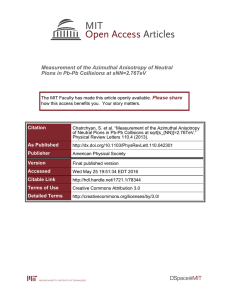
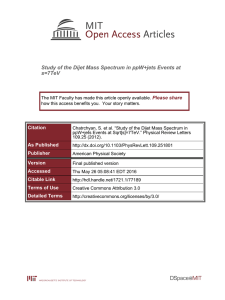
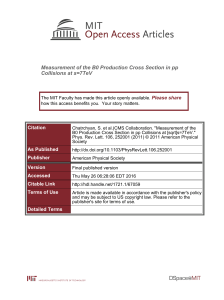
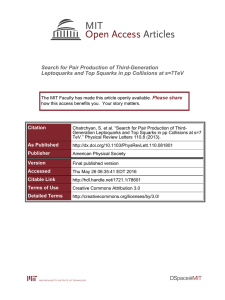
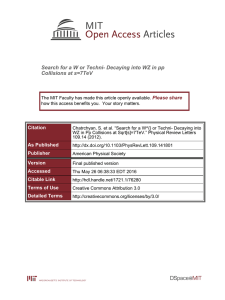
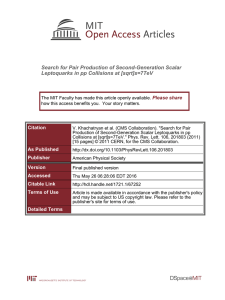
![Measurement of the B+ [B superscript +] Production](http://s2.studylib.net/store/data/012103466_1-28aa28c45049a2f4a947fa08ca5122bc-300x300.png)
